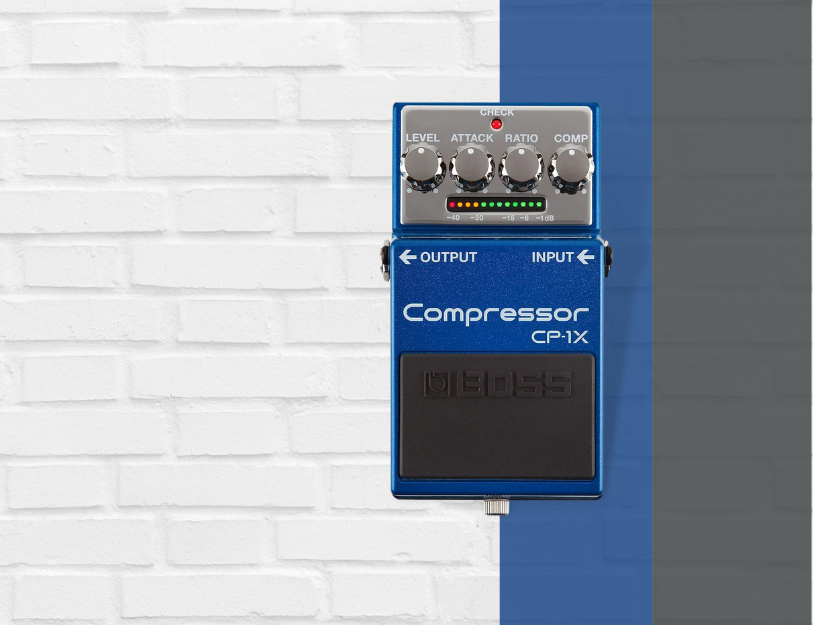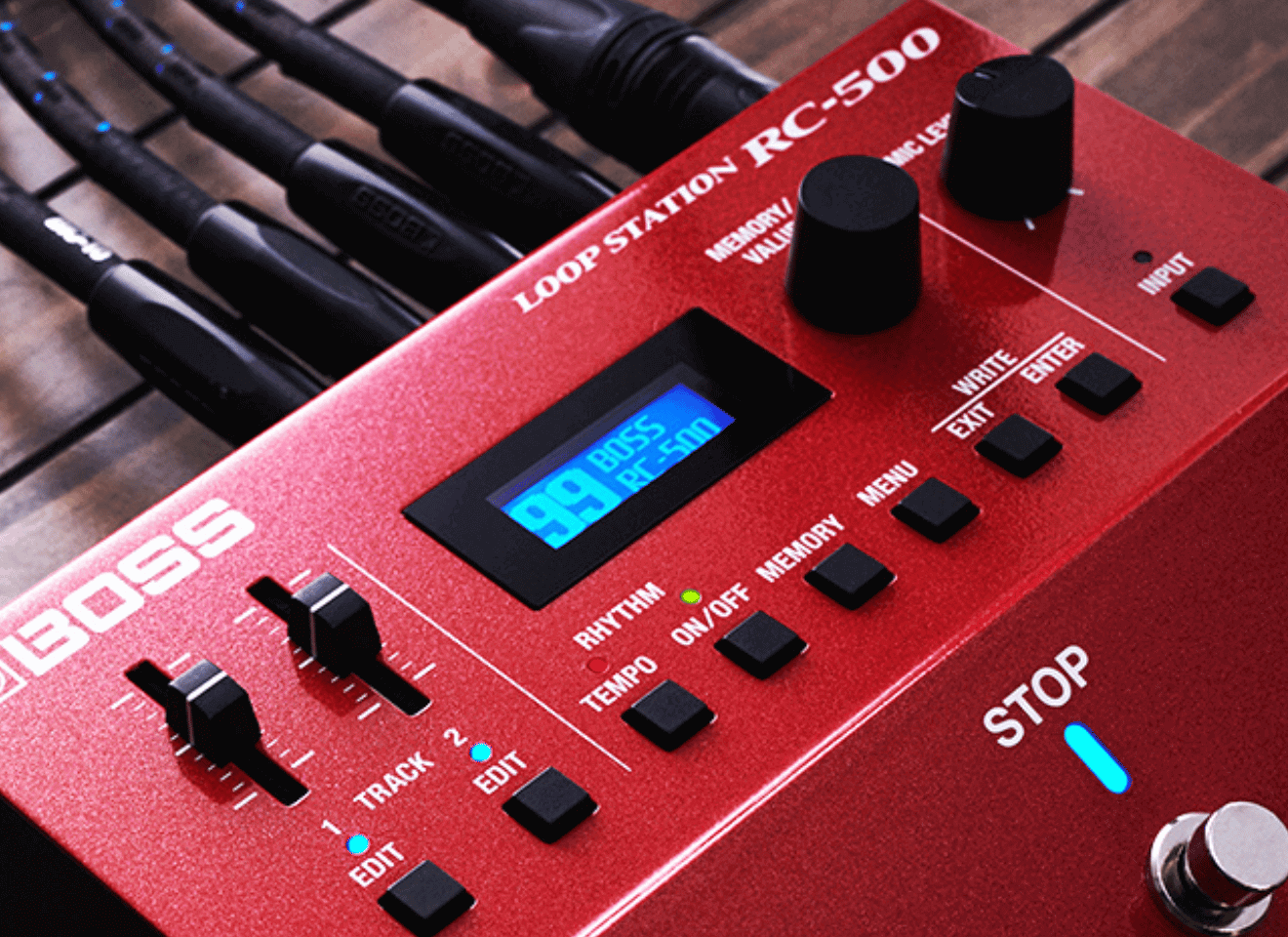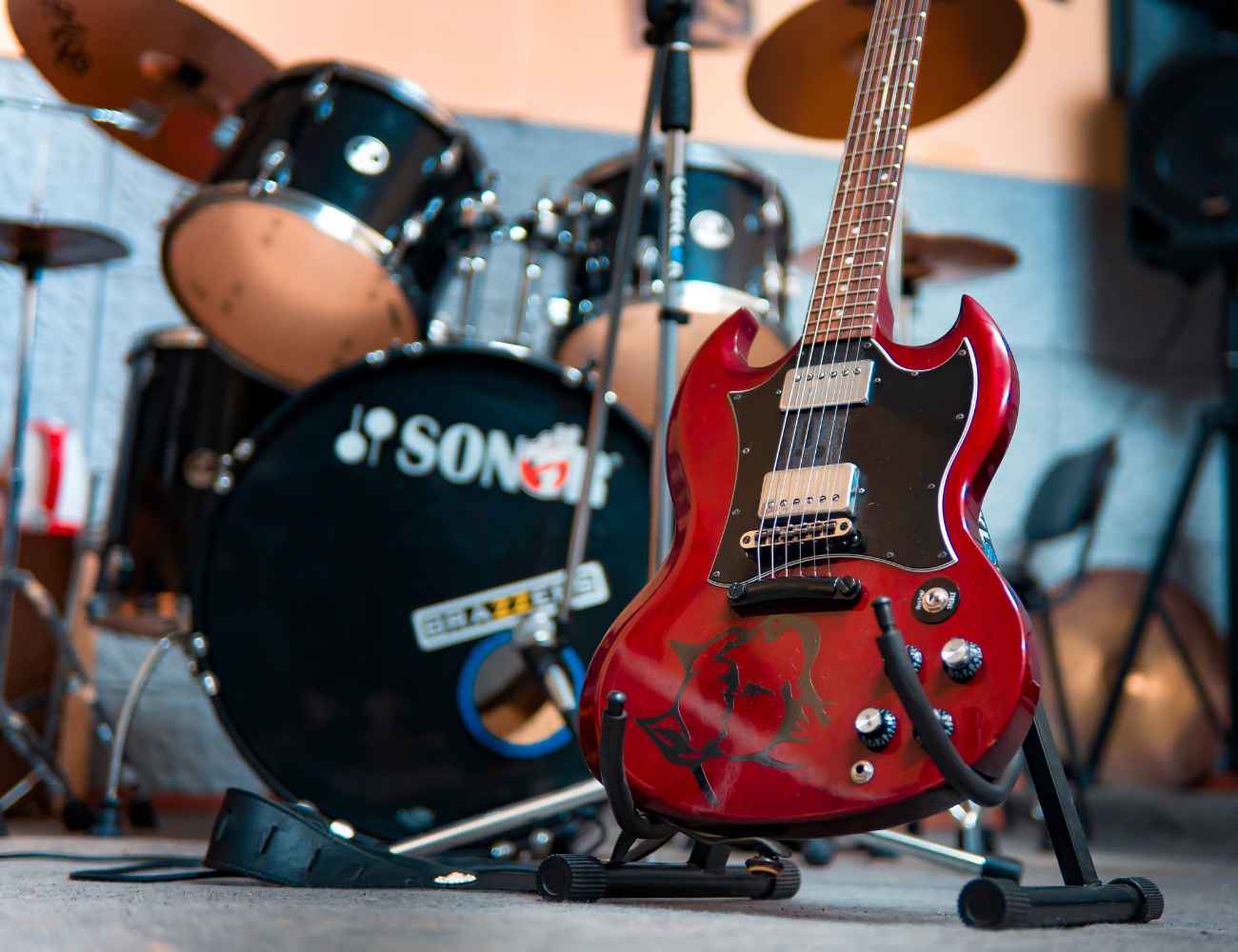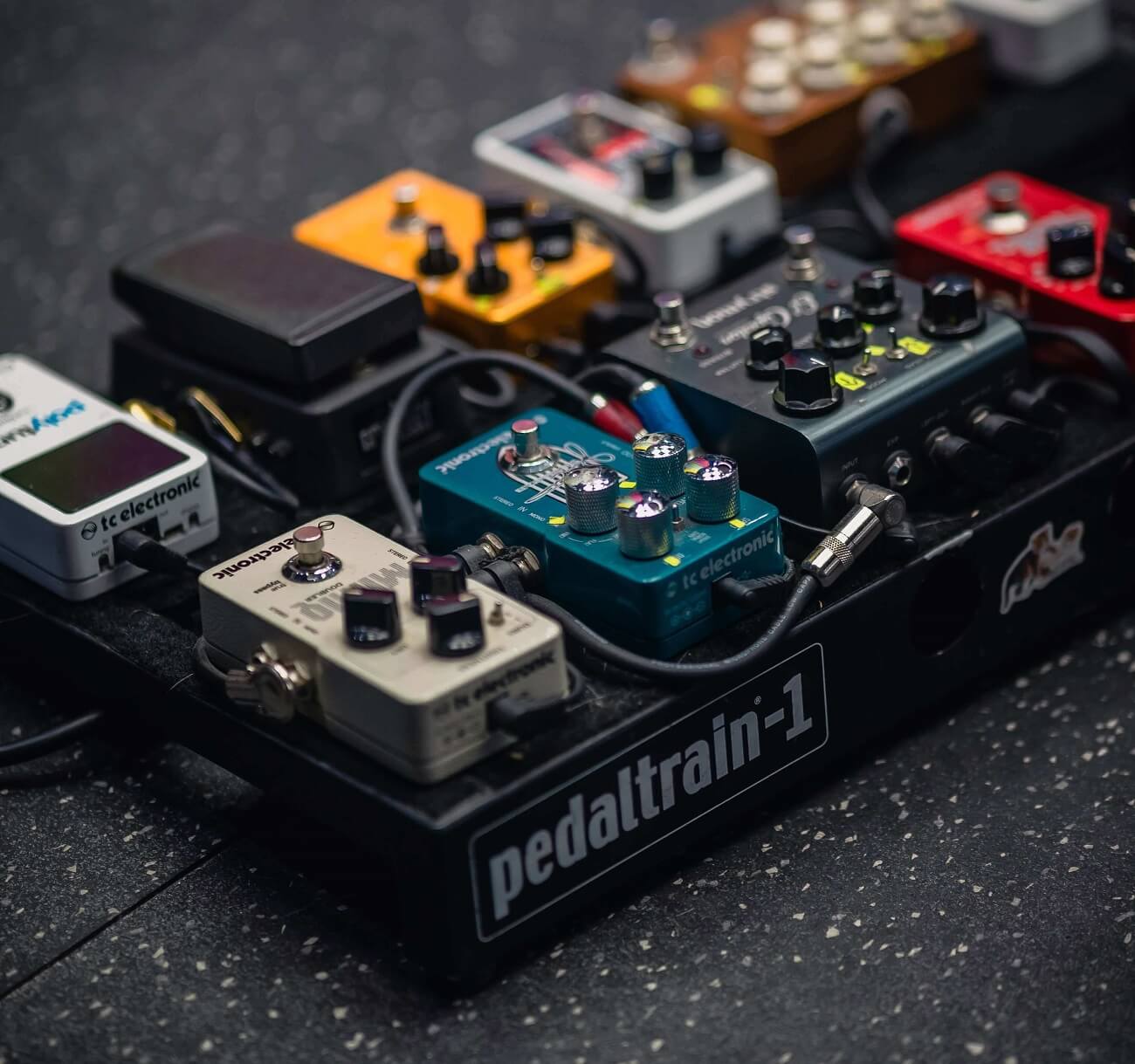Is your electric guitar sounding a bit off? Perhaps it’s time to explore the magic of compressor pedals.
A good compressor pedal can tighten your tone, adding sustain and giving your solos, or playing in general that professional sheen.
Finding the best compressor pedal can be a game-changer for both budding guitarists and gigging pros.
In this article, I’ll try to create the ultimate guide to these sound-enhancing treasures, outlining what to look for, the key features, and our top picks for every budget.
Aside from that, I’ll also go over some of the most frequently asked questions on this topic, so that you can have a better idea of what to look for.
Table of Contents
- Best Compressor Pedals
- Boss CP-1X Compressor Guitar Effects Pedal
- ThorpyFX The Fat General V2 Compressor Effects Pedal
- Origin Effects Cali-76 Compact Deluxe Compressor Pedal
- Keeley Compressor Plus Pedal
- Darkglass Electronics Hyper Luminal Hybrid Compressor Pedal
- MXR Dyna Comp Deluxe Compressor Guitar Effects Pedal
- Boss CS-3 Compressor/Sustainer Pedal
- Wampler Ego Compressor V2 Guitar Effects Pedal
- MXR Studio Compressor Guitar Effects Pedal
- TC Electronic Hypergravity Compressor Guitar Pedal
- Seymour Duncan Studio Bass Compressor Pedal
- Fender The Bends Compressor Pedal
- Xotic SP Compressor Pedal
- Orange Kongpressor Analogue Class A Compression Guitar Pedal
- Wampler Mini Ego Compressor Guitar Effects Pedal
- MXR M291 Dyna Comp Mini Compressor Pedal
- JHS Pulp N’ Peel V4 Compressor Guitar Effects Pedal
- What exactly is a compressor pedal?
- What should you consider when choosing a compressor pedal?
- How to properly use a compressor pedal?
- – Familiarize yourself with the controls and features
- – Adjust the parameters to suit your musical goals
- – Incorporate the compressor pedal into your signal chain
- – Set the threshold level for compression
- – Adjust the attack and release settings to tailor the pedal’s response
- – Fine-tune the output level for balance in your tone:
- – Experiment with different settings and styles to achieve your desired sound:
- How to order pedals on a pedalboard?
- Boutique vs. Mass-Produced pedals
- How much should you spend on a guitar pedal?
- Can you use a guitar pedal with a bass guitar?
- How to properly power your pedals?
Best Compressor Pedals
Before I begin, here are my top selected choices:
TC Electronic Hypergravity Compressor Guitar Pedal

Studio-quality multiband compressor with vintage-style compression and tons of TonePrints. Check Price
|
|
Boss CS-3 Compressor/Sustainer Pedal

Smooth sustain with tonal shaping for superior sound. Check Price
|
Boss CP-1X Compressor Guitar Effects Pedal
Smooth compression with 18V power for superior tone.
EMG’s T System is a prewired pickup set designed to upgrade Telecaster-style guitars. It features a solderless installation and provides bright, responsive, and noiseless sound. The control plate comes with all the necessary components for a simple setup.
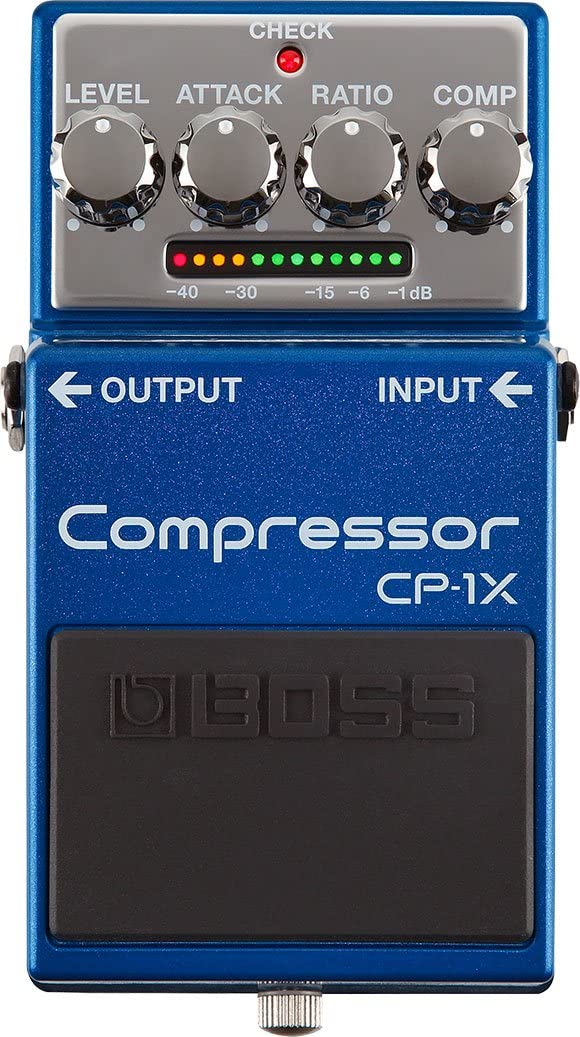
Designed by the renowned brand BOSS, this model brings a compact design that’s easy to carry and handle.
Measuring 5.71 inches in length, 3.66 inches in width, and standing just 2.36 inches tall, it’s ideally sized to fit into most pedalboards.
With a weight of around 580 grams, it’s light enough to transport easily.
You’ll find it operates efficiently at an electrical supply of 18 volts.
Crafted in a classic BOSS style, it showcases a modern aesthetic that complements any guitar setup.
While it’s an open-box product, the quality and performance remain uncompromised.
As you explore this pedal, you’ll appreciate the thoughtful design and technical aspects that make it a great addition to any guitarist’s toolkit.
- My Review
Right off the bat, I’ve got to say the Boss CP-1X Compressor Guitar Effects Pedal packs a punch.
It isn’t merely the quality you’d expect from BOSS but the compact style that sets it apart.
Its handy dimensions make it a perfect fit for almost any pedalboard.
Despite its slight weight of 580 grams, it doesn’t compromise durability.
The sturdy build means this pedal can take some knocks without impacting performance. And boy, what a performance it is!
Plugging it in, the device draws a decent 18 volts of power, so you can be sure of its capability. Soundwise, the pedal is a gem.
It creates a sheen in the tones, adding a lovely depth that harmonizes and balances the overall output. Plus, the sustain lasts for ages.
This pedal doesn’t just add sparkle; it makes every note count, especially during complex arpeggios and funky rhythms.
However, it’s not all rainbows. One downside is the pedal’s high energy consumption.
I frequently switched batteries, which can be a bit of a hassle.
Power supply usage is highly recommended here.
Also, beginners may find this pedal a tad overwhelming due to the myriad parameters available.
Understanding its full potential and how to tweak it to achieve the desired sound takes some time.
On another note, the LED indicators, while useful, do seem to be a bit over the top and can potentially cause problems if they malfunction.
Also, the bypass feature could use some work, as it slightly alters the tone when not in use.
Despite a few hiccups, the Boss CP-1X Compressor is still a worthy addition.
Here are the ratings I’ll give to the Boss CP-1X Compressor Guitar Effects Pedal:
If you’re looking for a pedal that will enhance your sound and withstand the test of time, this could be the one for you.
Just be ready to dedicate some time to understanding its nuances and quirks.
- Pros:
- Excellent sound quality.
- Enhances tone and clarity.
- Compact and portable design.
- Wide range of usable parameters.
- Quiet operation.
- Cons:
- High power consumption.
My final verdict is that the Boss CP-1X Compressor Guitar Effects Pedal (Open Box) is an excellent choice for guitarists looking for a compact and versatile compressor pedal.
It offers exceptional sound quality, enhances tone and clarity, and has many usable parameters.
The pedal performs well and operates quietly.
Its reputable brand and good value make it a solid option for guitarists seeking a reliable, high-performing compressor pedal.
ThorpyFX The Fat General V2 Compressor Effects Pedal
Robust, transparent, and clear compression for guitarists.
The FAT GENERAL provides clarity, sustain, and balance to your signal without excessive noise or signal pumping. It features a robust build, premium components, and a beautiful stainless steel laser-etched center console. Perfect for guitarists looking for a transparent but articulate sound.
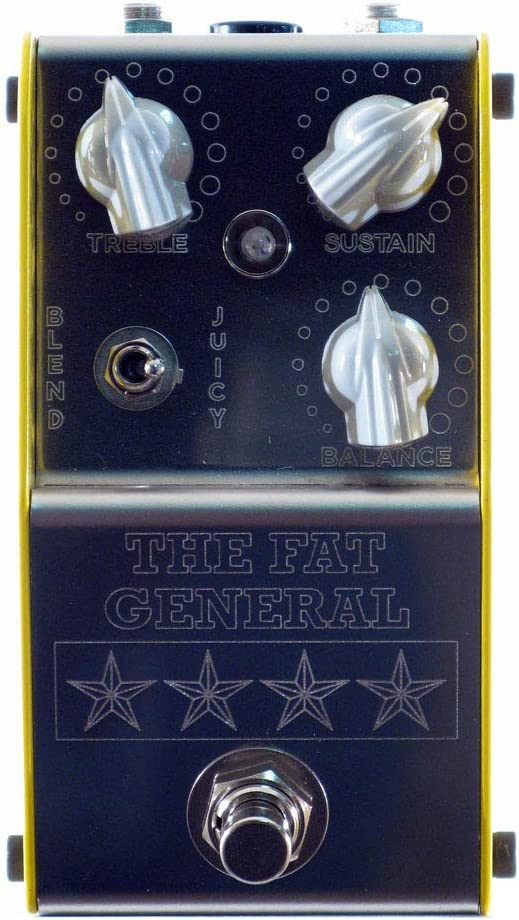
Meet ThorpyFX’s Fat General V2, a standout compressor effects pedal designed for the discerning guitarist.
It has been fine-tuned as an upgraded version of the highly regarded OTC-201 compressor to deliver a harmonious balance and extended sustain without adding unwanted noise or signal disruptions.
Its nuanced transparency brings out a crisp, sparkling quality that might have gone unnoticed in your sound.
Built for both robustness and style, its durable frame houses top-of-the-line internal components.
Quality is the game’s name here, with premium-grade 1% metal film resistors, first-rate capacitors from Wima and Panasonic, Neutrik jacks, and a Burr-Brown Opamp forming the heart of this pedal.
In addition, its smart design includes practical features like recessed knobs and top-mounted jacks, and it’s encased in a striking stainless steel body featuring a laser-etched center console.
- My Review
You bet the ThorpyFX Fat General V2 Compressor Effects Pedal leaves a lasting impression right from the get-go.
There’s something truly remarkable about its transparent yet sparkly sound that breathes life into every note, highlighting nuances that could easily go unnoticed.
Its ability to extend sustain without excess noise or signal disruptions brings a unique balance to your sound.
It’s like having a dependable partner ensuring every note you play is heard as you intend.
On top of the standout performance, the build quality is second to none.
It’s like this pedal was designed to endure the rigors of studio sessions and live performances while looking stylish.
The recessed knobs and top-mounted jacks are thoughtful touches that add to their practicality.
This pedal’s internals are a dream come true for any tone enthusiast.
With components like 1% metal film resistors, Wima and Panasonic capacitors, Neutrik jacks, and a Burr-Brown Opamp, it’s clear that ThorpyFX didn’t hold back in ensuring the Fat General V2 lives up to high expectations.
And the result? An impeccable sonic performance justifies the choice of these high-quality elements.
But it doesn’t stop there. There’s an inherent versatility to this pedal.
While I found a sweet spot using the blend mode, some may prefer the juicy mode that allows more control over the volume.
However, in blend mode, getting the overall level to unity does require a bit of tweaking on the sustain level, which I found a tad limiting.
Here are the ratings I’ll give to the ThorpyFX The Fat General V2 Compressor Effects Pedal:
Ultimately, this pedal doesn’t merely deliver; it captivates.
Despite minor quirks, the ThorpyFX Fat General V2 Compressor Effects Pedal marked my musical journey.
- Pros:
- Transparent and balanced signal
- Minimal noise with Reticon-based flanger
- Durable and robust build quality
- Cons:
- Limited adjustability for overall level
- No user-adjustable blend control
My final verdict is that the ThorpyFX Fat General V2 Compressor Effects Pedal is an exceptional choice for guitarists seeking transparent and balanced compression.
It’s minimal noise and sustain-enhancing capabilities deliver a high-quality tone and reliable performance.
The pedal’s durable build, premium components, and attractive design enhance its appeal.
Although it may have some adjustability and blend control limitations, it offers great value for its features and functionality.
Considering the positive reviews from satisfied users and with a solid brand reputation, this compressor pedal is worth considering for guitarists searching for professional-grade compression effects.
Origin Effects Cali-76 Compact Deluxe Compressor Pedal
Studio-grade FET compressor with intuitive features and intuitive dry blend control.
The Cali76 Compact Deluxe is a limited edition, 1176-style FET compressor with a discrete Class-A circuitry, studio-grade preamp, and dedicated parallel compression control in a compact, stompbox-sized package. It offers silent switching, signal-conditioning bypass mode, and advanced power supply filtering and protection for any source.
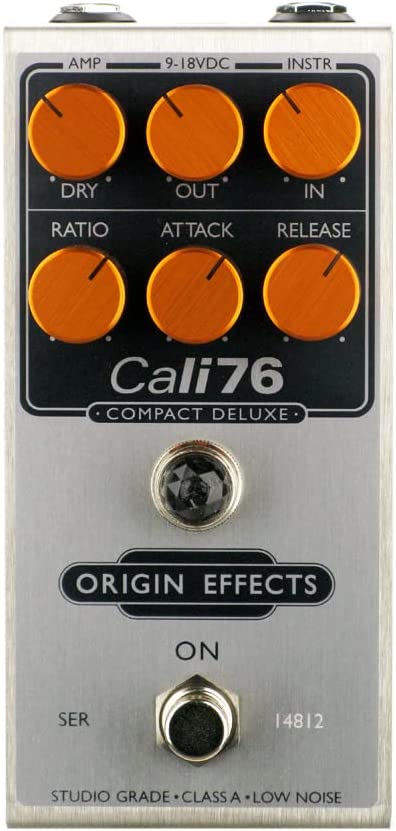
Meet the Origin Effects Cali-76 Compact Deluxe, a marvel of a guitar pedal that’s turning heads with its unique studio-grade compression capabilities.
Encased in a compact, stompbox-sized package, this elegant compressor pedal is one-of-a-kind, boasting a Gray color complemented by vibrant Orange knobs.
What sets it apart? The meticulous 1176-style design is packed with high-current, low-noise, Class-A circuitry, for starters.
But there’s more. Its parallel compression control allows exceptional precision and flexibility in shaping your sound.
Control options for attack, release, and ratio allow you to customize your tone from subtle transient control to flat-out limiting and remarkable sustain.
Plus, the integrated jewel lamp provides three-color gain reduction metering in an intuitive design.
However, what steals the show is the Dry Blend control, which seamlessly mixes your raw signal with the compressed guitar tone for true parallel compression.
A game changer in sound technology, indeed.
- My Review
You wouldn’t believe how the Origin Effects Cali-76 Compact Deluxe can redefine your sound experience until you plug in and play.
Immediately noticeable is the tangible studio-grade quality of this compressor.
Its performance reflects an amalgamation of detailed engineering and musical understanding, designed in the style of the revered 1176.
It’s a real sonic wonder with high-current, low-noise, discrete Class-A circuitry packed in a compact frame.
Unique in design and versatile in function, it enhances your sound in unimagined ways.
Plus, its dedicated parallel compression control, something seldom seen in guitar pedals, provides an edge by letting you shape your sound precisely.
Navigating through the controls, you’ll find separate dials for attack, release, and ratio.
These aren’t just decorative. Each adds a new dimension to your sound.
They give you the power to transition smoothly from subtle transient control to striking sustain.
What’s particularly impressive is the intuitive three-colour gain reduction meter – an elegant jewel lamp that brings a vintage touch to your rig.
Perhaps the highlight is the Dry Blend control, which enables true parallel compression by letting you mix your dry signal with the compressed tone.
It’s a feature that doesn’t just tick a box; it expands the palette of tone, allowing you to achieve anything from a warm, subtle compression to a super-tight squash.
Although the price tag might cause a moment’s hesitation, it’s essential to remember that the Cali-76 isn’t just a pedal; it’s a high-quality piece of gear.
Here are the ratings I’ll give to the Origin Effects Cali-76 Compact Deluxe Compressor Pedal:
It’s an investment into a rich, detailed sound, and, believe me, the Cali-76 delivers beyond expectations.
This compact wonder isn’t about changing your sound; it’s about enhancing it, helping your guitar find its voice with an unmistakable character and tone.
- Pros:
- Superb sound quality and improvement.
- Highly adjustable with flexible control options.
- Transparent and clean compression.
- Dry Blend control for parallel compression.
- Studio-grade FET response.
- Cons:
- Relatively high price compared to other compressors.
- May require some time to find the optimal settings.
My final verdict is that the Origin Effects Cali-76 Compact Deluxe, Limited Edition Gray with Orange Knobs is an exceptional product with outstanding features, versatile performance, and a reputable brand.
It offers superb sound quality, transparent compression, and a range of control options for optimal customization.
While the price may be relatively high compared to other compressors, the overall value and the enhancement it brings to tone and sustain make it worth considering for serious musicians.
Keeley Compressor Plus Pedal
Versatile Keeley Compressor Plus Pedal with Release Switch, Tone Control and Blend Control for improved sound.
Keeley Compressor Plus provides superior compression, limiting, and sustain in an easy to use package, featuring a Release Switch, Tone Control, and Blend Control. This makes it the perfect choice for any musician looking to get a professional sound out of their instrument.
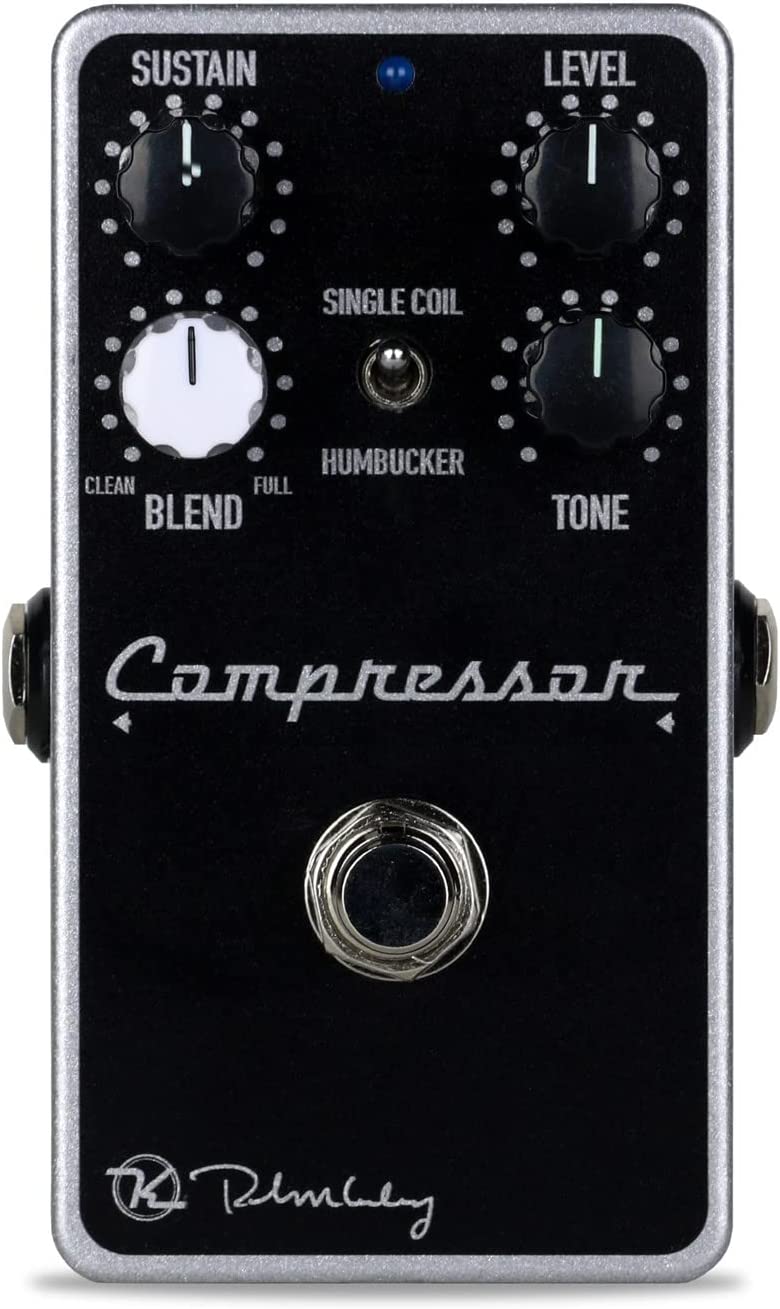
The Keeley Compressor Plus Pedal is in a sleek black design with enhanced features that are straightforward and effortless to use.
This novel pedal is tailored for single coil and humbucker pickups, thanks to its handy release switch that alleviates any confusion over attack or release settings.
It’s equipped with an eloquent tone control that accentuates those delicate harmonics which can often get lost in the compression process.
Notably, it has a blend control that ensures your guitar’s signal maintains its proper phase and peak sounds.
This Keeley Compressor Plus builds upon the tradition of delivering that enticing frequency push and tone sweetening, but now with a newfound adaptability that can cater to any instrument.
It’s a tool and a true partner in delivering the professionally recorded sound you desire for your instrument.
With its compact size of 6.75 x 4.25 x 3.25 inches, this pedal is easily portable and fits perfectly in any setup.
It operates on a 9-volt power supply, making it energy efficient and stage-friendly.
This product knows compression and how to make your instrument stand out in the mix – it’s all about the Keeley Compression Plus!
- My Review
I’ve got to say I was quite impressed with the Keeley Compressor Plus Pedal.
The minute I unboxed it, I noticed its sleek black design, which exuded a sense of quality.
This was a promising start as someone who values both form and function.
Plugging it in, I found it to be remarkably intuitive to use.
Its blend control immediately caught my attention, allowing me to maintain my guitar’s natural phase and peak sounds.
I found this feature to be particularly vital, as it lets the authenticity of the guitar’s tone shine through, even with compression in effect.
Adjusting the tone control, I discovered it does a fine job of preserving and even enhancing harmonic intricacies, those delicate tones that often get lost with other compressor pedals.
It was certainly music to my ears.
Furthermore, the release switch – designed specifically to cater to single coil and humbucker pickups – was admirable.
It eliminated any worries I had about the attack or release settings.
Using it was a breeze, and its flexibility for different pickups was a tremendous advantage.
Despite all these impressive attributes, what won me over was the natural adaptability of the Keeley Compressor Plus.
No matter the instrument I used, it brought out its full potential, providing that elusive studio-quality sound I sought.
However, it wasn’t without its minor drawbacks.
For instance, while I loved the portability due to its compact size, I did notice that the smaller controls might be a bit finicky for those with larger hands.
But, all said and done, the Keeley Compressor Plus Pedal demonstrated its understanding of compression.
Here are the ratings I’ll give to the Keeley Compressor Plus Pedal:
It’s more than just a tool; it’s an effective partner that can help any instrument stand out.
It’s truly an embodiment of the phrase, “Big things come in small packages.”
- Pros:
- Instantly enhances clean sound
- Delivers high-quality and unique compression
- Retains peak dynamics and proper phasing
- Flexible for any instrument
- Great for slide guitar
- Cons:
- May introduce noise/hum in some setups
- Not suitable for bass guitar
- May not surpass certain competitor models
My final verdict is that the Keeley Compressor Plus Pedal is a highly versatile and feature-rich compressor pedal that delivers excellent tone and performance.
Its intuitive controls and ability to retain peak dynamics offer great flexibility for various instruments.
The positive reviews highlight its effectiveness in enhancing clean sound and compatibility with different setups.
However, some users have reported noise issues and limitations for bass guitars.
Overall, considering its brand reputation and value for the price, the Keeley Compressor Plus Pedal is a solid choice for guitarists seeking enhanced compression capabilities.
Darkglass Electronics Hyper Luminal Hybrid Compressor Pedal
Darkglass Electronics Hyper Luminal Hybrid Compressor – studio-level compression in a compact pedal.
This collection of eight analog compressor plugins emulate classic studio hardware and provide intuitive control, allowing you to tailor the compression to the source material. Features include mix knob, auto-release, and parallel compression for a comprehensive set of side-chain options.
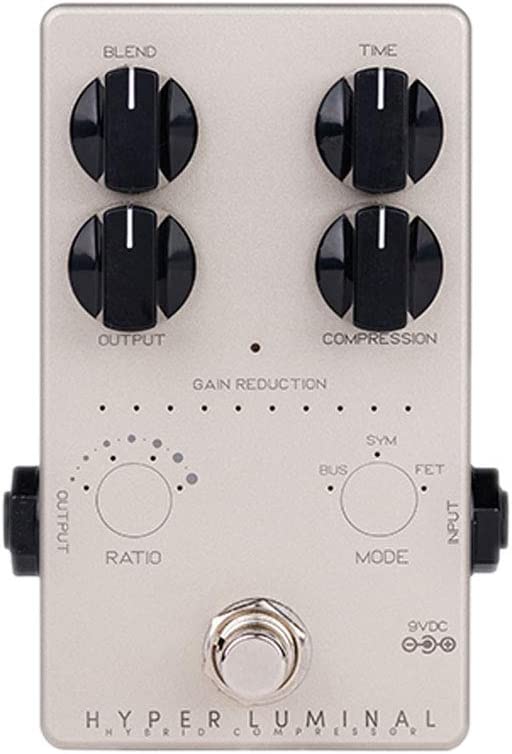
Delving into the world of Darkglass Electronics, we stumble upon the Hyper Luminal Hybrid Compressor, a tool that is a boon for bassists and composers alike.
Uniquely designed, this silver marvel weighs a light 230 grams and has dimensions of 10 x 7 x 5 inches.
However, its ability to mimic three different types of compressors truly sets it apart, creating a versatile range of sound effects.
The key features of this device include adjustable compression knobs and a ratio mode, which can be controlled through-metal sensors.
It is further equipped with an output, time, and blend functionality, all designed to allow you to customize your sound to your liking.
It also sports a 10-segment gain reduction meter, enhancing its overall functionality.
What might catch your interest is including a USB interface that extends its capabilities, offering even more potential for sound manipulation.
Every aspect of this device caters to delivering a studio-level sound experience, providing a fine blend of the old and the new bundled into one compact pedal.
- My Review
Ah, the Hyper Luminal Hybrid Compressor by Darkglass Electronics.
This little beast of a pedal left an indelible mark on my soundscaping journey.
With an uncanny ability to simulate three distinctive compressor styles, it carves out a niche in the versatility arena.
We’re talking about the Solid State Logic Bus, the famed 1176, and Darkglass’s retired gem, the Super Symmetry, all housed in this compact device.
I reveled in the blend control, which offered an intriguing mix-and-match game with my signals.
Moving on to the time, output, and compression knobs, I was amazed at the range of tonal variations at my fingertips.
You’ve got a suite of controls to play with, whether you want that sublime subtlety or to dial up the drama with intense coloration.
One particular feature that stood out was the through-metal senss, which enabled me to change the ratio mode in a rather tactile and satisfying manner.
The 10-segment gain reduction meter was another charm, neatly bridging the gap between the digital and the analog.
A bone I had to pick with the pedal was its build quality.
Darkglass Electronics products are known for their tank-like durability, but the Hyper Luminal felt less robust.
This could make it susceptible to scratches and minor damages over time, especially for those who frequently gig or tour.
The included USB interface was a welcomed feature.
It expanded the pedal’s scope beyond its physical limitations, enabling a range of adjustments via the Darkglass Suite application.
Nonetheless, I wish the connection was USB-C instead of micro-USB – a minor niggle, but worth noting.
Finally, an issue surfaced when cranking the settings to extreme levels, causing a noticeable hiss.
Admittedly, most compressors share this caveat, but it’s something to be aware of.
However, Darkglass’s responsiveness to issues was commendable in its defense, addressing problems diligently and swiftly.
The Hyper Luminal is an asset in any musician’s arsenal.
Here are the ratings I’ll give to the Darkglass Electronics Hyper Luminal Hybrid Compressor Pedal:
Yes, it has its quirks, but its sheer versatility and sound-shaping prowess make it a compelling choice.
Despite some drawbacks, it’s clear why this pedal has garnered such acclaim.
- Pros:
- Great compressor with versatile modes
- USB connectivity for customization
- Solid build quality
- Transparent compression with minimal tone alteration
- Positive feedback from users
- Cons:
- Some users reported gain reduction light issues
- Potential hiss in extreme settings
- Build quality not as durable as other Darkglass pedals
- Micro-USB connection instead of USB-C
- Power issues reported by a few users
My final verdict is that the Darkglass Electronics Hyper Luminal Hybrid Compressor is an excellent bass compressor pedal with a range of versatile features.
It offers transparent compression, minimal tone alteration, solid build quality, and positive user feedback.
While there were a few reported issues, such as gain reduction light problems and potential hiss in extreme settings, this pedal’s overall performance and value are highly regarded.
Its USB connectivity for customization and the ability to emulate three different compressor models provides musicians with a valuable tool for enhancing their bass tones.
Considering its positive attributes, I believe the Darkglass Hyper Luminal Hybrid Compressor is recommended for bass players seeking professional-quality compression effects.
MXR Dyna Comp Deluxe Compressor Guitar Effects Pedal
Classic compression sound with modern controls.
The Dyna Comp Deluxe Compressor brings classic percussive tonality with modern control and transparency, allowing you to blend your unaffected signal with the compressed signal, and adjust its attack and tone. Ideal for vintage and modern styles of compression.
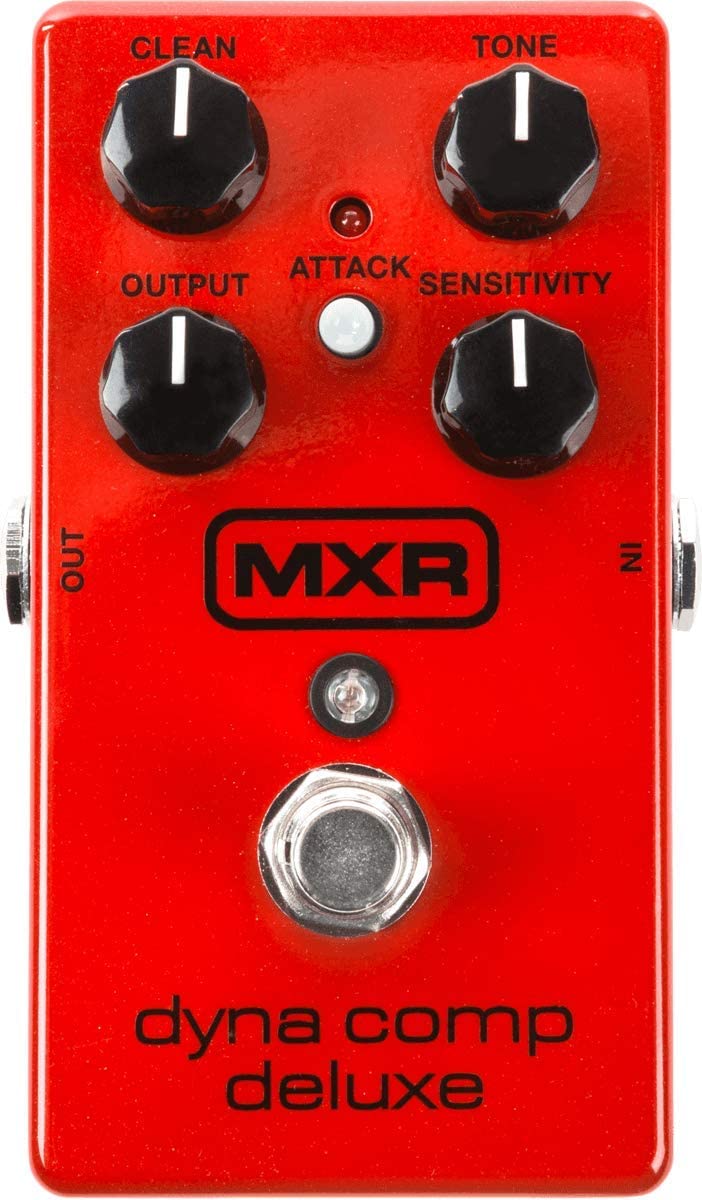
If you’re an electric guitar player looking for a way to fine-tune your sound, the MXR Dyna Comp Deluxe Compressor, sporting an appealing red color, could be the tool for you.
This device is no ordinary effects pedal; it’s been engineered to deliver control that takes you back to the unmatched compression sound that marked a milestone in the history of effects pedals.
Moreover, its unique built-in CA3080 “metal can” integrated circuit elevates the vintage feel of the device, resulting in quieter operation, clear transparency, and a larger dynamic range.
You can also personalize your sound with the “Clean” control, blending your original signal with the compressed one for a balance that’s just right.
An additional “Tone” control enables further tweaks of the compressed signal, while the “Attack” switch lets you flip between vintage-style slow and modern-style fast attack times.
Lastly, there are knobs for “Output” and “Sensitivity” to control volume level and sustain length, respectively, ensuring you get just the sound you want.
Crafted by the New York-based MXR, this pedal embodies the company’s tradition of creating high-quality effects units.
- My Review
In red, its sleek look gives it a dash of style.
What makes it more than just a pretty face is its dynamic control that unlocks a new level of sound quality, reminiscent of the iconic compression tones that once defined an era in pedal effects.
I could appreciate the subtlety and flexibility it brought to my sound.
The innovative CA3080 “metal can” integrated circuit is where the magic happens.
Its tranquil operation was impressive, and its clear, rich, dynamic range left me with numerous tonal options.
A noteworthy feature is the ‘Clean’ control.
It’s a game changer, allowing me to blend my original signal with the compressed one, achieving a balance that felt like a personal signature.
The pedal allows for creative control, making it a joy to experiment with.
The ‘Tone’ control was also quite versatile.
It allowed me to shape my compressed sound, adding an extra layer of customization to my music.
With the ‘Attack’ switch, I could easily alternate between a vintage-style slow and a modern-style fast attack time.
This proved essential in setting the right mood for different pieces.
Lastly, the ‘Output’ and ‘Sensitivity’ knobs were functional and precise.
They allowed me to modulate the volume level and the length of sustain, finely adjusting the dimensions of my sound.
Though it might be intimidating for beginners due to its diverse controls, this pedal grows on you.
The more you explore it, the more you appreciate the depth of control it offers.
Here are the ratings I’ll give to the MXR Dyna Comp Deluxe Compressor Guitar Effects Pedal:
MXR has delivered a fantastic product for musicians ready to push their sound to new frontiers.
The Dyna Comp Deluxe Compressor is not merely a tool; it’s a key that opens the door to a new world of sonic possibilities.
- Pros:
- Transparent and iconic compression sound
- Flexible control over compression parameters
- Clean blend control for blending unaffected signal
- Toggle between vintage and modern attack styles
- Cons:
- Relatively higher price compared to other compressors
- May require some tweaking to find optimal settings
My final verdict is that the MXR Dyna Comp Deluxe Compressor Guitar Effects Pedal is a highly versatile and feature-rich pedal with excellent tone and performance.
The MXR brand is well-regarded, and the value provided by this pedal is satisfactory.
Its transparent compression sound, flexible controls, and ability to blend unaffected signals offer guitarists a wide range of possibilities.
While it may have a relatively higher price than other compressors and may require some tweaking to find optimal settings, it is a solid choice for musicians seeking a reliable, high-quality compressor pedal.
Boss CS-3 Compressor/Sustainer Pedal
Smooth sustain with tonal shaping for superior sound.
The CS-3 Compression Sustainer pedal provides smooth, natural sustain with minimal tone degradation. It features Level, Tone, Attack and Sustain controls for precise tonal shaping, and the low-noise design allows for quiet operation. Perfect for guitarists and bassists.
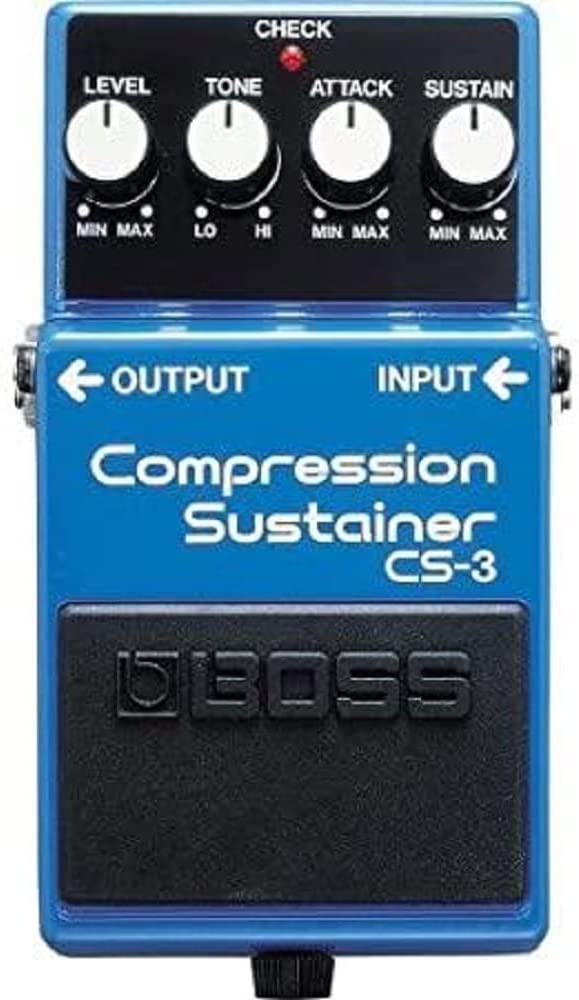
This pedal, the Boss CS-3 Compressor/Sustainer, comes in a classic blue tone, a common characteristic of the Boss brand.
Sized at approximately 6 x 3.75 x 2.7 inches and weighing just over a pound, it has been specifically engineered for guitarists and bassists who wish to augment their sound quality.
The product’s main function is to moderate the intensity of louder signals while enhancing lower ones, ensuring that your music maintains its smooth sustain and original tonal quality.
This versatile pedal has multiple onboard controls, such as Level, Tone, Attack, and Sustain, allowing musicians to shape their tone precisely.
Moreover, it’s designed to operate silently, making it an excellent choice for artists who want to concentrate on their sound without background noise distractions.
This Boss CS-3 pedal has become a vital accessory for musicians seeking their best sound.
- My Review
Having spent significant time with the Boss CS-3 Compressor/Sustainer Pedal, I appreciate its proficiency and versatility.
With its compact, sturdy design, it’s the kind of tool that exudes dependability right out of the box.
One of its key strengths lies in its ability to boost softer signals and compress louder ones, ensuring that your music doesn’t lose its original tonal quality while maintaining a smooth sustain.
The fact that it operates with minimal background noise is a big plus.
Silence is golden, after all, especially when every note counts.
Another thing I found impressive was the array of onboard controls.
Level, Tone, Attack, and Sustain knobs allow you to fine-tune your output and shape the exact sound you’re after.
With these controls at your disposal, you can tweak your sound to your heart’s content, making the CS-3 a flexible addition to your pedal collection.
Yet, while it’s mostly a joy to use, it’s not without its quirks.
For instance, the battery life seems too short for extended playing sessions.
This is something to remember if you’re a player who spends long periods away from a power source.
I also noticed that while the CS-3 shines when playing clean, the sustain effect can sometimes feel a bit punchy when used with distortion.
This might not sit well with those who enjoy heavy distortion.
So, despite a couple of drawbacks, the CS-3 Compressor/Sustainer Pedal is a well-rounded piece of equipment.
Here are the ratings I’ll give to the Boss CS-3 Compressor/Sustainer Pedal:
It’s solidly built, versatile, and provides excellent sound shaping capabilities.
Just remember to keep a spare battery handy, and you’ll be set to create beautiful music with this pedal.
- Pros:
- Smooth sustain without distortion
- High-quality sound
- Well-regarded brand
- Great sustain and compression
- Improves overall tone
- Cons:
- Short battery life
- May cause volume fluctuations
- Noisy at high settings
- May require additional noise gate
- Not suitable for certain music styles
My final verdict is that the Boss CS-3 Compressor/Sustainer Pedal is a highly recommended choice for guitarists and bassists seeking smooth sustain and compression.
With its high-quality sound, solid performance, and the reputation of the BOSS brand, it offers great value for its price.
While it may have minor drawbacks, like short battery life and potential noise issues at high settings, the overall positive reviews and versatile features make it a reliable and worthwhile addition to your pedalboard.
Wampler Ego Compressor V2 Guitar Effects Pedal
Smooth sustain and versatile control with Wampler’s Ego Compressor V2.
This versatile compressor pedal delivers a range of tones, from smooth sustain to full country twang. Wampler’s Ego Compressor offers unparalleled control for the perfect sound.
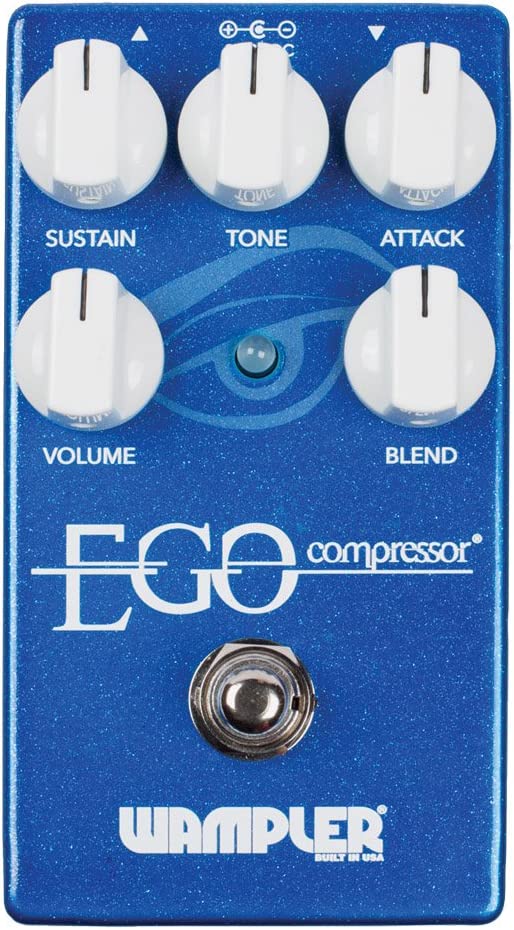
This guitar effects pedal gives guitarists added control during their performances.
It’s created to retain the original tone and dynamics of the instrument and lets you blend your original signal in, giving you the compression benefits without the unwanted ‘squash.’
Moreover, this pedal is versatile.
Whether after a full country ‘squash’ or a parallel compression at the studio level, this device can help you achieve it.
At its heart, it boasts an array of controls and a pure core tone, which makes it an excellent choice for continuous use or as an occasional effect.
This pedal, part of the Ego Compressor series, is designed in a Wampler branded box with dimensions measuring 7 x 4 x 7 inches and weighing comfortably 0.34 kilograms.
With a built-in blend control, it becomes a game changer for achieving the perfect tone.
It provides versatile, quiet, and transparent operation as an additional feature.
- My Review
I had the opportunity to try out the Wampler Ego Compressor V2 Guitar Effects Pedal, and let me tell you, it’s a game-changer.
This pedal is designed to retain your playing dynamics without coloring your tone and lives up to that promise.
With its comprehensive array of controls and a pure core tone, this compressor can be used as an “always on” pedal or purely as an effect.
One outstanding feature of the Ego Compressor is the ability to blend your original signal in, allowing you to enjoy the benefits of compression without losing your guitar’s original tone.
This means you can achieve anything from a full country squash to a barely noticeable studio-level parallel compression, making it incredibly versatile.
The Ego Compressor is also very well-built and compact, occupying minimal space on my pedalboard.
Its controls are easy to understand and adjust, making finding the perfect settings for my desired sound simple.
Additionally, this compressor is remarkably quiet, with minimal noise, even when combined with other pedals in my chain.
While the pedal has mostly exceeded my expectations, I did encounter a few minor issues.
The initial input jack was tight, making it slightly difficult to plug in a 1/4-inch cable.
Furthermore, there were a few instances when the switch would “pop” a bit too loudly when engaging the pedal, although this was not a deal-breaker for me.
In my experience, the Wampler Ego Compressor V2 is an excellent addition to any guitarist’s pedalboard.
Its versatility, ease of use, and quality construction make it stand out from other compressors on the market.
Here are the ratings I’ll give to the Wampler Ego Compressor V2 Guitar Effects Pedal:
Although it’s not without minor flaws, the benefits and sound quality far outweigh any minor inconveniences.
I’d highly recommend trying this pedal; it just might become an indispensable part of your rig.
- Pros:
- Transparent and quiet
- Versatile with adjustable blend control
- Retains playing dynamics and tone
- Great sustain and compression
- High-quality build and craftsmanship
- Cons:
- Possible noise issues with certain setups
- Tone switch may not have noticeable effect
- Some units may have build quality issues
My final verdict is that the Wampler Ego Compressor V2 Guitar Effects Pedal is a highly versatile and feature-rich pedal that delivers exceptional tone and performance.
Its transparent compression and ability to retain playing dynamics cater to various musical genres.
The brand’s reputation for high-quality craftsmanship adds to its appeal.
While some noise and build quality concerns may exist, it offers great value for guitar players seeking a reliable and effective compressor pedal.
MXR Studio Compressor Guitar Effects Pedal
MXR Studio Compressor delivers clear, clean compression in a pedal-sized package.
MXR is a renowned manufacturer of high-quality effects pedals for guitarists, offering classic and modern tones. Their pedals are designed to be easy to use and provide a wide range of sounds for any genre of music. MXR’s pedals are built for lasting durability, with premium-grade components and construction.
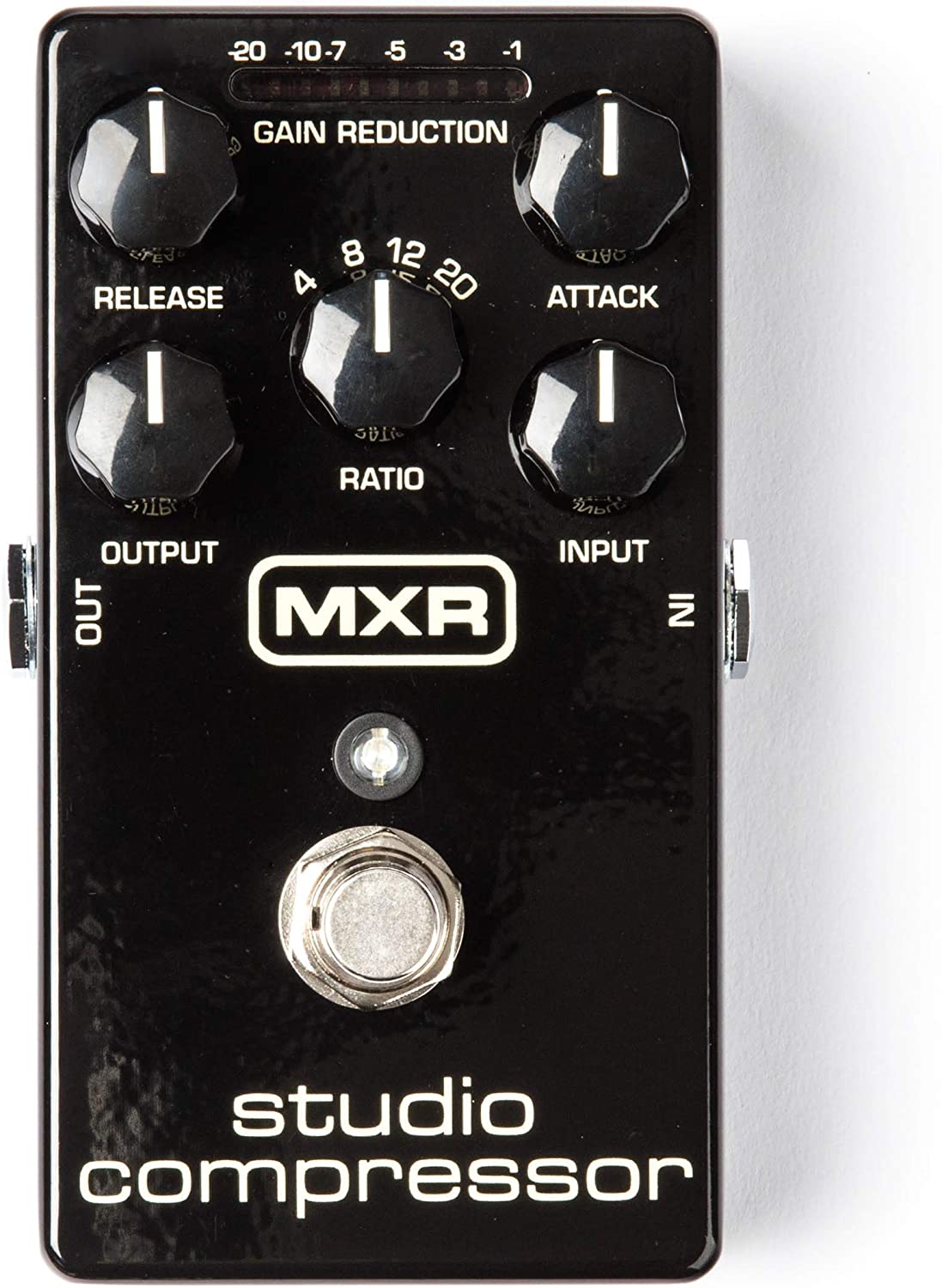
The MXR Studio Compressor Guitar Effects Pedal, designed by Jim Dunlop, offers musicians a high-quality compression effect in a compact, easy-to-use pedal format.
This compressor aims to replicate the classic studio sound and is housed in a durable black casing similar to the Phase 90 pedal.
With Keith Barr and Terry Sherwood co-founding the New York-based MXR company in 1972, innovative guitar effects pedal design is at the brand’s core.
Unique features of this pedal include MXR’s Constant Headroom Technology for a crisp and transparent performance.
Additionally, ten gain-reduction status LEDs allow you to monitor the compression effect visually.
The true bypass design ensures your signal remains unaffected when the pedal disengages.
Lastly, the model number of this specific pedal is M76, and it measures 5.5 x 4.5 x 2.5 inches while weighing only 0.7 pounds.
- My Review
Upon using the MXR Studio Compressor Guitar Effects Pedal, I immediately noticed how significantly it enhanced my sound quality and presence.
Whether I was playing bass, guitar, or even recording vocals, this pedal consistently performed with clarity and precision.
The Constant Headroom Technology played a significant role in providing a clean and transparent performance.
One aspect that impressed me was how quietly this pedal operated.
Unlike many other compressor pedals, there was no noticeable “popcorn” noise, which is a massive advantage for recording sessions or live performances.
Being such a versatile device, I found it suitable for various instruments and music styles.
However, I must admit that it doesn’t seem to be the perfect choice for the Nashville “chicken pickin” style.
Adjusting the settings on this pedal proved reasonably intuitive, with ten gain-reduction status LEDs displaying the compression level.
Although some controls, such as the output level, could benefit from an expanded range of sweep, I appreciated having a visual aid to monitor the effect.
As for the build quality, the sturdy black casing offered a solid, durable design that I’m confident can withstand frequent use.
Its compact size makes it a convenient addition to any pedalboard without wasting too much space.
Regarding the value, I believe that this pedal is a reliable and valuable investment for musicians seeking a stable compressor to improve their sound quality.
On the other hand, the extremely bright blue LED indicator could be distracting on stage and may need some masking tape to tone it down.
Here are the ratings I’ll give to the MXR Studio Compressor Guitar Effects Pedal:
In my experience, the MXR Studio Compressor Guitar Effects Pedal is a dependable, high-quality compressor fit for various instruments and musical styles.
While there’s room for improvement in some features, it remains an excellent choice for those looking to enhance their sound and presence on stage or in the studio.
- Pros:
- Enhances sound quality and presence.
- Versatile for multiple instruments and vocals.
- Quiet performance, no “popcorn” noise.
- Cons:
- Not suitable for Nashville “chicken pickin” style.
- Output control has limited range of sweep.
- Extremely bright blue LED indicator.
My final verdict is that the MXR Studio Compressor Guitar Effects Pedal is a versatile, high-quality compressor with excellent sound-enhancing capabilities, suitable for various instruments and vocals.
It has minor drawbacks in playability and design features, but overall, it is a reliable and valuable addition to any musician’s gear collection.
TC Electronic Hypergravity Compressor Guitar Pedal
Studio-quality multiband compressor with vintage-style compression and tons of TonePrints.
HYPERGRAVITY COMPRESSOR is a multiband compressor with vintage mode and TonePrints, providing studio-quality compression, classic stompbox sounds, and customizable compression tones. With its optimized headroom, True Bypass or Buffered Bypass switch, and Kill-Dry on/off, this pedal ensures optimal tonal integrity and a wide range of compression options.
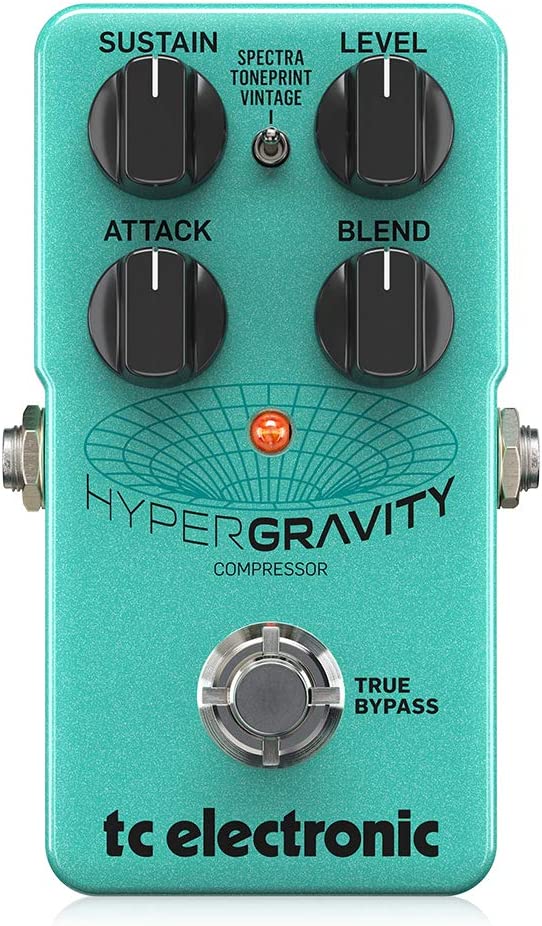
The TC Electronic HyperGravity Compressor is a multiband compression pedal for guitar players with remarkable versatility and customization options.
It has three modes: studio-quality multiband compression (Spectra), a classic stompbox compressor (Vintage), and unlimited compression possibilities through TonePrint technology.
This compact pedal lets you explore a range of compression sounds and effects, from airy shimmers to tightly controlled dynamics.
Constructed with a sturdy multi-colored chassis, the pedal measures 5 x 3 x 4 inches and weighs 0.32 pounds.
Its key features are buffered and true bypass options, ensuring your signal quality remains intact.
One standout aspect of the HyperGravity Compressor is its compatibility with TonePrint®, a signature effect technology, letting you easily access custom presets created by professional musicians or even make your compression profile.
In addition to its USB port for connecting to a computer, the pedal introduces advanced MD3 compression algorithms used in professional studio gear.
This allows fine-tun compression for different frequency bands — highs, mids, and lows — to create transparent and musically satisfying results.
- My Review
I recently had the opportunity to try out the TC Electronic HyperGravity Compressor, and I must say, it’s quite an interesting pedal.
With its studio-quality multiband compressor, Vintage Mode for classic stompbox compression, and Tone Print capabilities, there’s a lot packed into this small, multicolored unit.
One thing that stood out to me was the multiband compression.
It is unique as it applies tailored compression to the high, mid, and low frequencies, allowing you to maintain a transparent, dynamic sound.
Using the Vintage Mode, I achieved tones reminiscent of classic, well-known compressors, which was a nice touch for those looking for an old-school compression vibe.
The major standout, however, is the Tone Print technology.
It offers incredible customization, allowing you to find the perfect balance for your sound.
However, it wasn’t all perfect.
The pedal seemed to be a little too digital for my taste.
In some instances, it even changed the overall tone in a slightly negative way, making it sound overly processed.
Additionally, I experienced a bit of noise when using the pedal, though this could be an issue with a specific unit rather than a widespread problem.
The HyperGravity Compressor is not as plug-and-play friendly as some other compression pedals, requiring extra time and effort to dial in the ideal settings.
But the possibilities are vast if you’re willing to invest that time.
So, while not suitable for everyone, especially those who prefer an analog sound, the HyperGravity Compressor is worth considering for players looking for a high level of control over their compression.
Here are the ratings I’ll give to the TC Electronic Hypergravity Compressor Guitar Pedal:
One thing to appreciate is the compact design and build quality, easy-to-access controls, and the added benefit of true or buffered bypass for tonal integrity.
Although it might not be perfect for every guitarist, there is much to appreciate in this versatile and feature-loaded pedal.
- Pros:
- Exceptional multiband compression.
- Vintage and Spectra Compression modes.
- Built-in customizable TonePrints.
- Cons:
- Can cause noise and complications.
- Potential pedal crashing issues.
- Not plug-and-play friendly.
My final verdict is that the TC Electronic HyperGravity Compressor offers great versatility and customization in a compact, well-built package.
While it may not suit those looking for a purely analog sound or plug-and-play simplicity, for those willing to invest time in exploring its potential, it can be a valuable addition to any pedalboard.
It’s a unique and innovative pedal with numerous options for creating a personalized compression tone.
Seymour Duncan Studio Bass Compressor Pedal
Studio-grade, transparent compression with versatile control.
This compressor pedal features a Blend knob & 3-way mini-toggle switch to customize your tone, and can be placed at the beginning or end of an effects chain. Experiment to find your ideal sound!
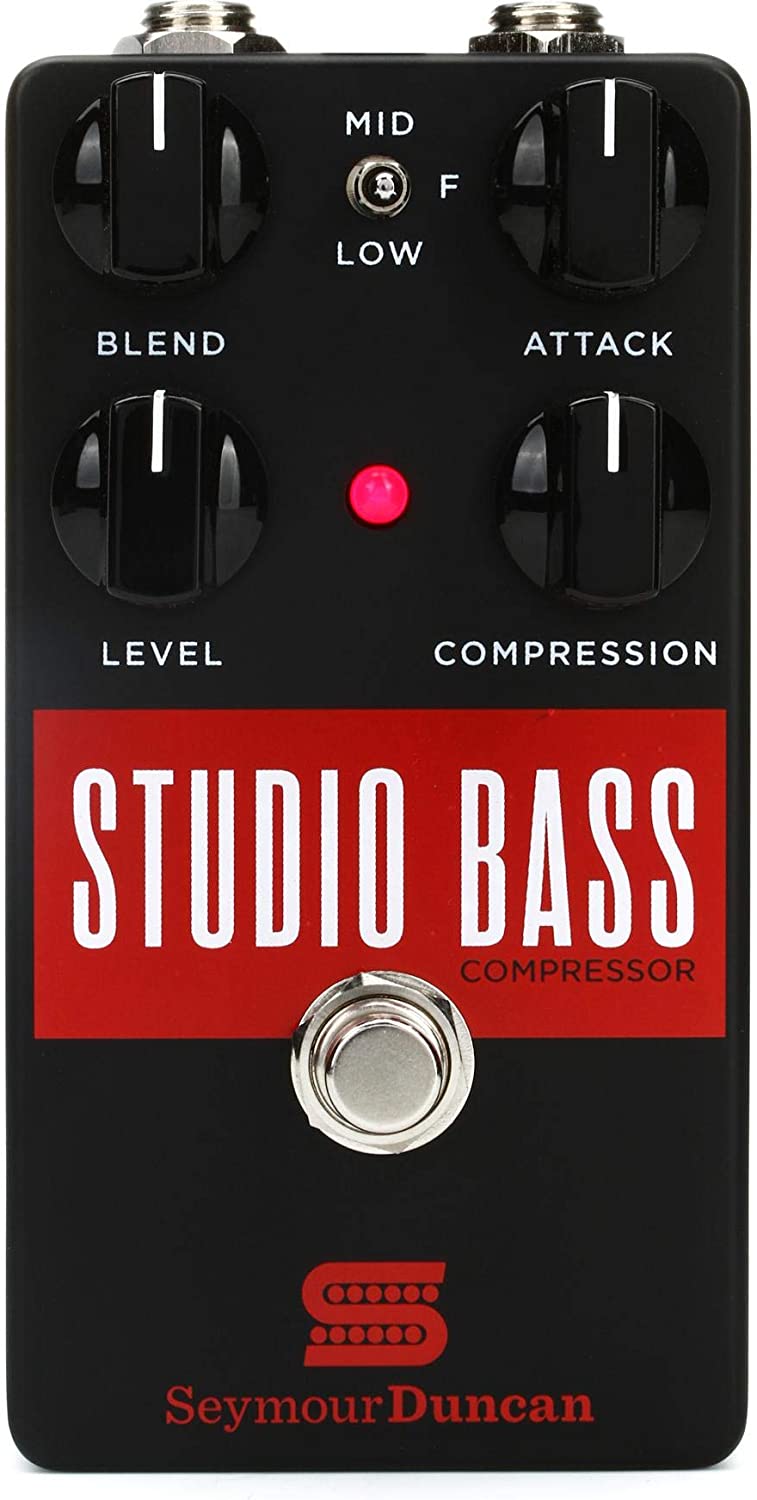
Seymour Duncan presents the Studio Bass Compressor Pedal – a high-quality bass compression effect pedal designed with musicians in mind.
This well-crafted pedal is constructed in Santa Barbara, California, featuring a simple yet effective four-knob layout that allows for user-friendly control and customization.
One of the standout aspects of this product is its transparent nature, effortlessly blending with the 805 Overdrive for an impressively tight grind.
The Studio Bass Compressor provides optimal tonal control through its Blend knob and a three-way mini-toggle switch, letting you choose the frequency range and adjust the balance between the wet and dry signal routed to the output.
It’s important to note that although putting a compressor at the beginning of your effects chain is generally recommended, you can experiment with this pedal’s placement to find what’s best suited for your sound.
Whether a beginner or a professional player, the Seymour Duncan Studio Bass Compressor Pedal offers a simple yet powerful tool to enhance and refine your bass tone.
- My Review
After trying out the Seymour Duncan Studio Bass Compressor Pedal, I’ve discovered numerous valuable attributes and areas with room for improvement.
This bass compression effect pedal is a studio-grade product, boasting a transparent design that works exceptionally well when paired with the 805 Overdrive to achieve a tight and refined sound.
What truly sets this pedal apart from others on the market is its versatile tonal control – thanks to its Blend knob and three-way mini-toggle switch.
This allowed me to experiment with different frequency ranges and strike the perfect balance between the wet and dry signals, ultimately tailoring the output to my preferences.
In terms of performance, the pedal immediately enhanced my bass tone, adding a layer of punch and consistency to my sound.
I particularly enjoyed how the compressor adjusted the natural sound of my bass and preamp – it made the slaps and pops sound even more impactful!
The pedal’s design and assembly in Santa Barbara, California, also indicate superior quality and craftsmanship.
However, I felt the pedal could be improved in several areas.
Firstly, I found the plastic battery door less durable than I had hoped, as it is prone to breaking if mishandled.
A more sturdy battery door made of metal would be a welcome improvement.
Secondly, despite being advertised as studio-quality, it emitted a noticeable amount of noise with my setup.
This could potentially hinder its performance in a recording environment.
It’s also worth noting that the price tag is on the higher side when compared to other compressors on the market.
Here are the ratings I’ll give to the Seymour Duncan Studio Bass Compressor Pedal:
The Seymour Duncan Studio Bass Compressor Pedal remains an exceptional tool for any bassist seeking to enhance their sound and gain incredible control over their tone.
Given its versatility, impressive features, and overall performance, I can confidently endorse this compressor as a valuable addition to any bassist’s arsenal.
- Pros:
- Studio-grade, transparent compression.
- Blend knob for tonal control.
- Designed and assembled in the USA.
- Cons:
- Plastic battery door prone to breaking.
- Some users report noise issues.
- Expensive compared to other options.
My final verdict is that the Seymour Duncan Studio Bass Compressor Pedal is a dependable and versatile product that can considerably enhance a bass player’s tone and control.
Despite a few areas for improvement, such as the plastic battery door and noise issues, its studio-grade quality, transparency, and blend control make this pedal a worthy investment for bassists of all levels.
Fender The Bends Compressor Pedal
Premium compression pedal with LED-illuminated knobs and magnetically latched battery door.
The Fender Bends Compressor features dual audio paths, a blend control, and high-current control path to give you dynamic and noise-free signal control. It also has LED-illuminated knobs, a magnetic battery door, and a lightweight, durable anodized aluminum construction for a reliable performance on stage.
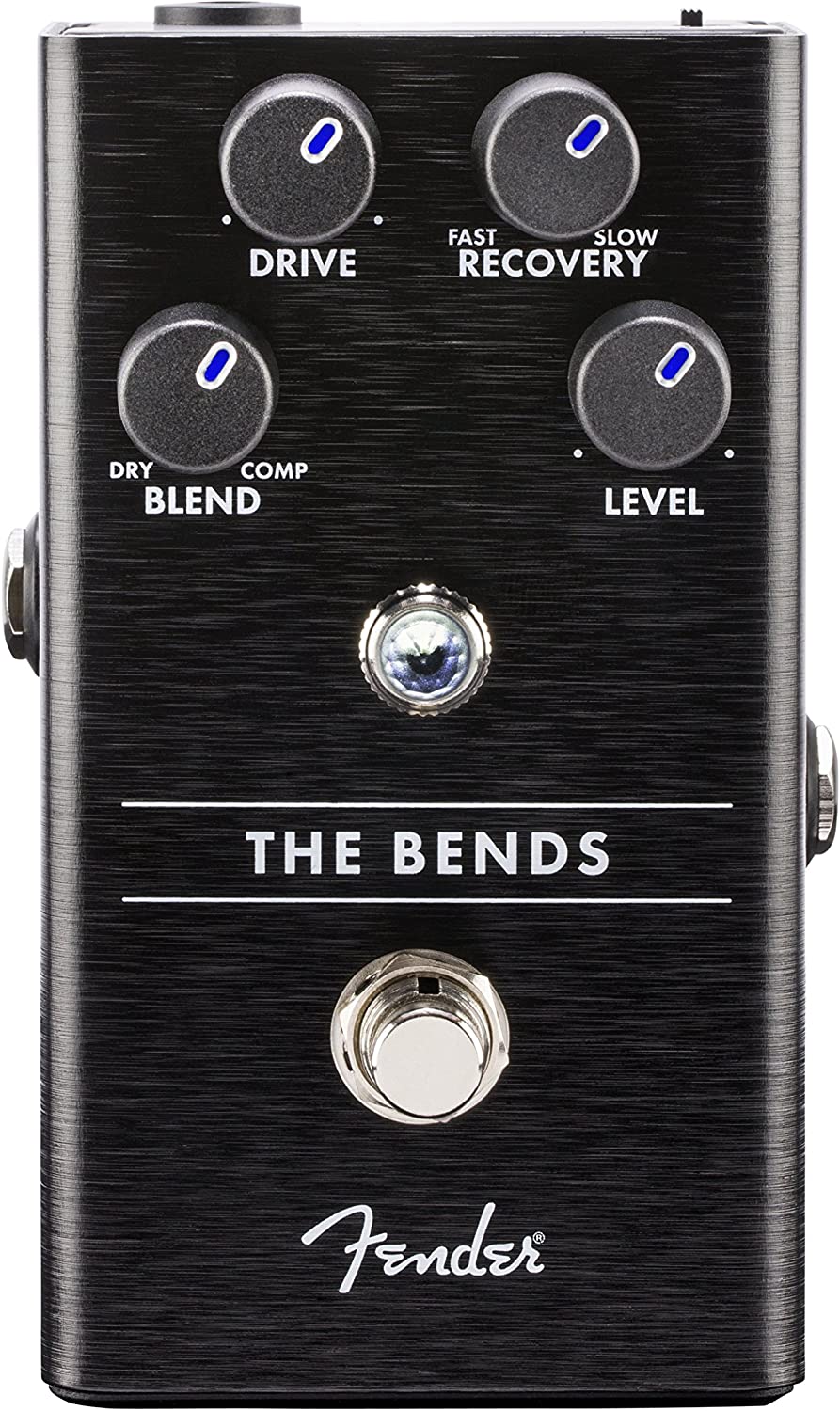
The Fender The Bends Compressor pedal is a high-quality option for musicians seeking a durable and versatile compressor for their guitar.
With its dual internal audio paths, this pedal ensures a low noise output and fast response time, courtesy of its high-current symmetrical control path.
The LED-backlit knobs and Fender amp Jewel LED provide excellent visibility on stage, making tweak settings during performances easy.
Built with an anodized aluminum body, the pedal is lightweight and can handle rigorous touring schedules.
Conveniently, it also features a magnetically latched hinged 9V battery door, allowing for quick and easy battery swaps.
Coming in a sleek black color, the pedal measures 5.45 x 4.85 x 3.25 inches and weighs just 454 grams.
The Bends Compressor offers a blend control that lets you mix in your dry guitar signal, preserving the natural playing dynamics while adding compression and control to your guitar tone.
Designed for the discerning guitarist, this pedal is an excellent choice for those who prioritize quality and performance.
- My Review
I recently had the opportunity to try out the Fender The Bends Compressor pedal, and I must say, it’s highly impressive.
To begin with, the pedal sports an extremely solid and lightweight design due to its anodized aluminum construction.
This instills confidence in its longevity and ability to withstand the rigors of touring.
One noteworthy feature of this compressor pedal is the dual internal audio paths that ensure low noise output.
I was pleasantly surprised with how transparent and clear the sound stayed while using this pedal.
The high-current symmetrical control path also contributes to its quick response time, making it perfect for various playing styles.
The LED-backlit knobs are great, providing visibility during darker stage performances.
However, I found the Fender amp Jewel LED to be quite bright, and while it is an asset in showing when compression is working harder, it could be overpowering for some users.
The blend control stands out; it enables me to mix the dry guitar signal, preserving natural playing dynamics while benefitting from the additional control the compression offers.
This pedal’s range of available compression settings is excellent for subtle adjustments that enhance the overall tone rather than completely altering it.
Despite its many strengths, I found the controls’ naming slightly confusing – for example, referring to the compression control as “drive.” While it’s a minor issue, it makes the initial learning curve steeper for those unfamiliar with compressors.
Here are the ratings I’ll give to the Fender The Bends Compressor Pedal:
In my experience using the Fender The Bends Compressor pedal, I’ve found it an excellent choice for guitarists looking for a transparent, well-built, and versatile compressor.
It may not deliver extreme compression, but it excels in creating dynamic and natural-sounding tones.
- Pros:
- Low noise output and fast response.
- LED backlit knobs for visibility.
- Preserves natural playing dynamics.
- Cons:
- Overpowering Fender amp Jewel LED.
- Confusing control naming conventions.
- Limited extreme compression ability.
My final verdict is that the Fender The Bends Compressor pedal is an excellent choice for guitarists who value transparent and dynamic compression.
Its solid construction and thoughtful features make it a reliable and performance-friendly option while still providing great value for the price.
Xotic SP Compressor Pedal
Wide range of tones, dry blend, up to +15dB boost, true bypass.
The Xotic SP Compressor features a blend knob, +15dB boost, and attack control, providing vintage to modern compressor tones. It’s true bypass ensures no signal interference when switched off.
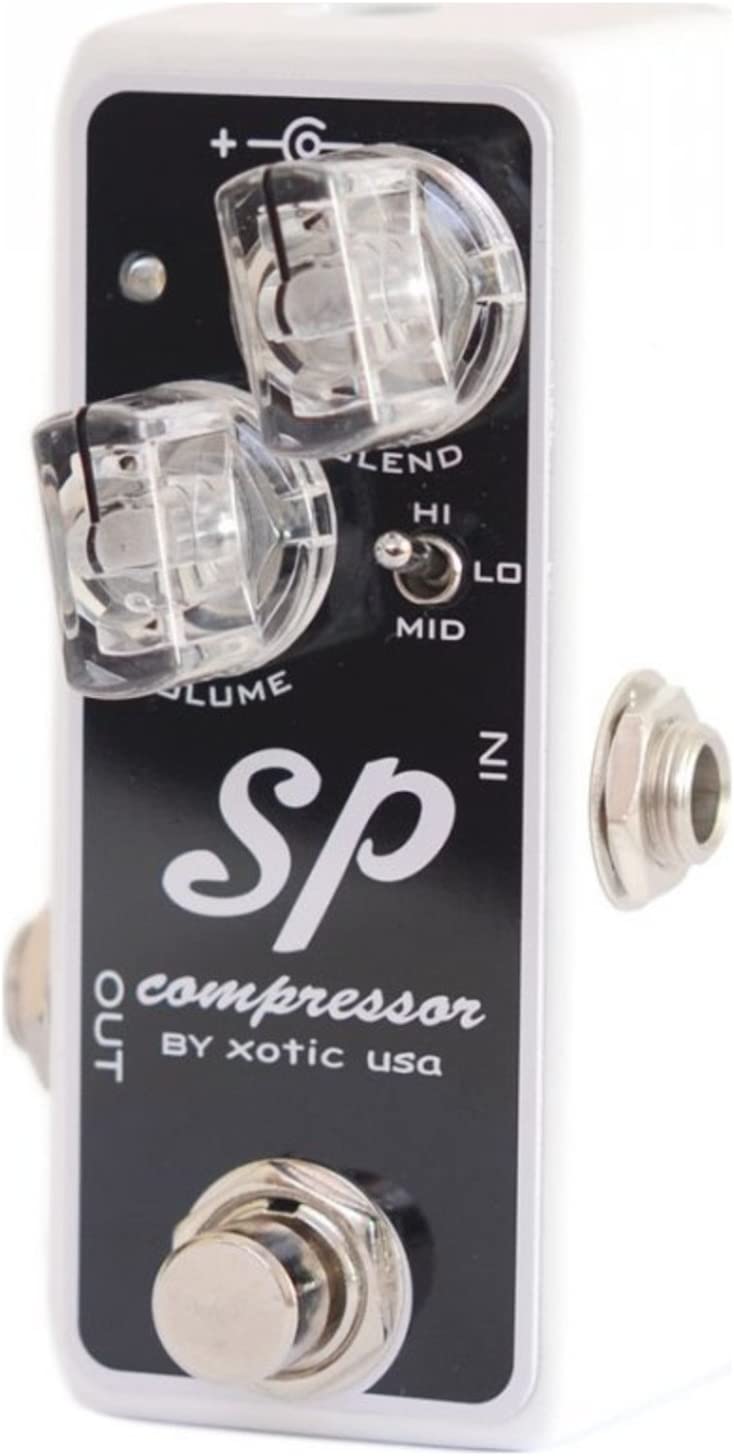
Meet the Xotic SP Compressor, a compact yet power-packed tool for musicians.
Housed in a sturdy, white metal chassis, it offers the same OTA technology that Ross Compressor users appreciate.
Its convenience is unparalleled with a diminutive size, roughly half of the typical single-effect pedals, yet it can accommodate a 9V battery.
It has various options, including a dry blend knob that allows you to mix the original and compressed signals, an internal dip switch for attack control, and a three-way switch to choose from at low, mid, and high compression levels.
This variety enables it to deliver anything from a transparent compression to a super squishy country comp, according to your needs.
Moreover, it offers true bypass switching, ensuring zero signal interference when switched off.
Its technical specifications include a power consumption of 9VDC/5mA, an input impedance of 1M ohm, an output impedance of 10k ohm, and a nominal input signal level of -20dB.
- My Review
I’ve given the Xotic SP Compressor a thorough run, and, let me tell you, it’s an impressive piece of gear!
Compact, but don’t let its size fool you – it’s versatile.
Its housing? Solid metal.
It feels like it can handle a rough night on stage or in the studio.
It’s also petite enough to squeeze onto a busy pedalboard comfortably.
The standout feature for me is the blend control.
It offers the ability to mix compressed and uncompressed signals, which allows you to maintain the integrity of your original tone while reaping the benefits of compression.
From transparent compression for subtly evening out those dynamics, to a wholesome clean boost, to full-on country squish – it’s got you covered.
It’s got three selectable compression levels – low, mid, and high – which means this pedal can adapt to whatever I throw at it.
Whether playing gently or digging in, I can dial in just the right amount of compression to suit my touch.
Now, about that true bypass – what a thoughtful touch!
Switching the pedal off doesn’t interfere with my signal, meaning my tone stays crystal clear.
Power consumption is another win; 9VDC/5mA is manageable and easy on the batteries.
One small critique, though – the internal dip switch for attack control is not as accessible as I’d like.
You have to open up the pedal to change it, which isn’t always convenient on the fly.
However, the bottom line is this pedal is a powerhouse.
And given its price point, it competes well above its weight class.
Here are the ratings I’ll give to the Xotic SP Compressor Pedal:
It’s got features, versatility, durability, and, most importantly, excellent tone-shaping capability.
The Xotic SP Compressor is truly a sound investment.
- Pros:
- Compact and space-saving design.
- Versatile with a wide range of compressor tones.
- Includes a blend control for signal mixing.
- Sturdy construction with a metal chassis.
- Low power consumption and battery-friendly.
- Cons:
- May not be suitable for certain musical genres.
- Limited availability of color options.
My final verdict is that the Xotic SP Compressor is an exceptional pedal with outstanding versatility, a wide range of features, and impressive tone quality.
Its compact design, sturdy construction, and low power consumption add to its appeal.
The brand’s reputation and reasonable pricing make it a valuable addition to any guitarist’s setup.
While there may be limited color options and not suit all musical genres, the overwhelmingly positive reviews and lack of negative feedback emphasize its excellence.
Orange Kongpressor Analogue Class A Compression Guitar Pedal
Studio quality compression with smooth bloom and boost.
Kongpressor is a vintage-style analogue Class A compressor pedal adding organic depth and dimension to any guitar rig. Its vactrol VTL5C3 optocoupler gives a re-issue of the classic sound heard on hits records.
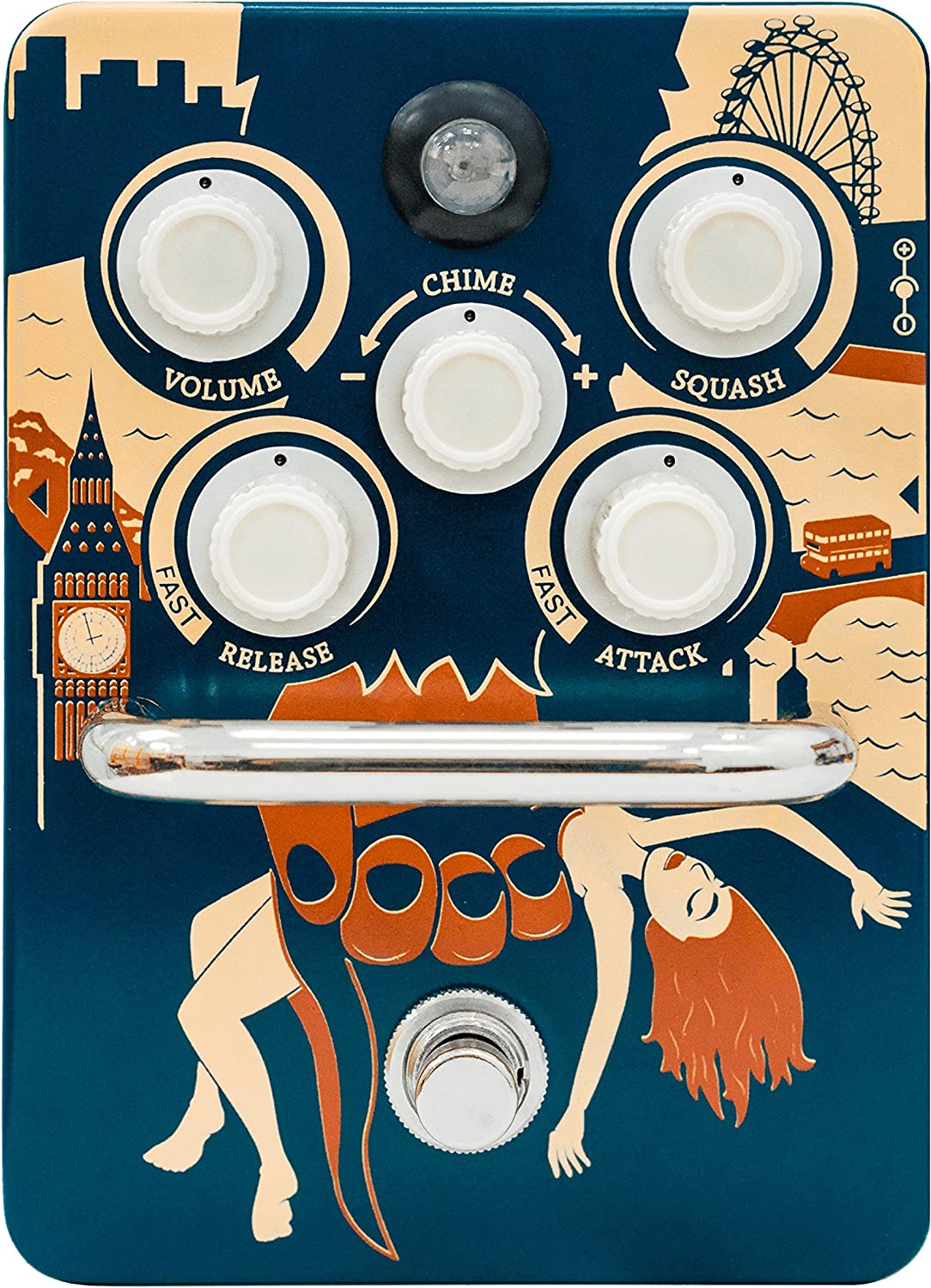
Orange brings you their Kongpressor, a guitar effects pedal that redefines the traditional notion of audio compression.
With a nod to vintage optical studio units, this analog Class A compressor offers a distinct three-dimensional sound, enhancing your rig’s sonic character.
Moreover, the Kongpressor boasts an internal charge pump, which increases your power supply voltage, ensuring top-tier performance.
It also has a 12dB clean boost feature, handy for punching through the mix when you need to stand out.
Sitting at dimensions of 6 by four by 5 inches and weighing in at 1.1 pounds, this pedal combines compactness with lightweight portability.
Its striking color scheme — a blend of orange and transparent hues — is a definite eye-catcher.
The Kongpressor goes beyond looks, with a transparent buffered bypass ensuring your signal integrity is maintained when the effect is off.
So, it’s not just about looking good; it’s about sounding good too.
- My Review
Stepping on the Orange Kongpressor for the first time, it’s clear that this guitar effects pedal has a certain ‘je ne sais quoi’ that sets it apart.
This analog Class A compressor does impart a three-dimensional quality to your sound, echoing the spirit of some iconic vintage optical studio units that musicians and producers alike have cherished for decades.
Something I particularly appreciated was the re-issue of the famous Vactrol VTL5C3 optocoupler.
Details like this contribute to a sonic character reminiscent of many revered hit records from yesteryears, adding a layer of nostalgia to your performance.
Now, let’s talk about the clean boost.
This 12dB gem is more than just a feature; it’s a game changer.
You can seamlessly cut through any mix with a subtle nudge, becoming the center of attention when you choose to.
But make no mistake; this is no one-trick pony.
The internal charge pump ensures consistent performance, eliminating the need to worry about voltage issues constantly.
On the design front, Orange stays true to its signature aesthetic with a blend of vibrant orange and transparent hues.
Not only does it look fantastic on my pedalboard, but the buffered bypass keeps the signal transparent when the effect is bypassed, a detail that speaks volumes about the thought that went into this pedal.
Despite its brilliance, the Kongpressor isn’t without its quirks.
While easy to navigate, the volume, squash, and chime controls could do with more range.
Sometimes, they felt slightly too subtle, and I would’ve liked a bit more dynamism.
Moreover, when pushed hard, the pedal might give off a slight overdrive/distortion, especially on heavier chords.
That could be a dealbreaker if you always need a pristine clean sound.
Here are the ratings I’ll give to the Orange Kongpressor Analogue Class A Compression Guitar Pedal:
The Kongpressor is a versatile and multifaceted pedal, blending impressive features with a couple of idiosyncrasies.
It’s a pedal I’d recommend for those seeking to add an organic texture to their sonic arsenal while bearing in mind its slight tendency to flirt with overdrive.
- Pros:
- Studio-quality compression
- Versatile and tweakable
- Transparent and natural compression
- Excellent build quality
- Provides volume boost
- Cons:
- Possible distortion at high squash settings
- May not meet overly squishy compression expectations
- Disappointing sound quality for some users
My final verdict is that the Orange Kongpressor Analogue Class A Compression Guitar Effects Pedal is a highly versatile and feature-rich pedal that delivers studio-quality compression.
It offers transparent and natural compression with excellent build quality.
The pedal’s control over attack and release and its ability to boost volume adds to its versatility.
While some users experienced distortion at high squash settings and had different expectations for squishy compression, overall, its tone and performance have received positive reviews.
The Orange brand is well-regarded, and considering its attractive design and value for money, this pedal is recommended for guitarists seeking a reliable and versatile compression option.
Wampler Mini Ego Compressor Guitar Effects Pedal
Compact, versatile compression with ultimate control.
The Mini Ego Compressor is a compact, powerful and versatile pedal, offering smooth, musical compression in a small, rugged package. Its unique design uses an analog signal path and a discrete Class A FET gain reduction circuit to deliver the perfect combination of natural feel and transparent tone.
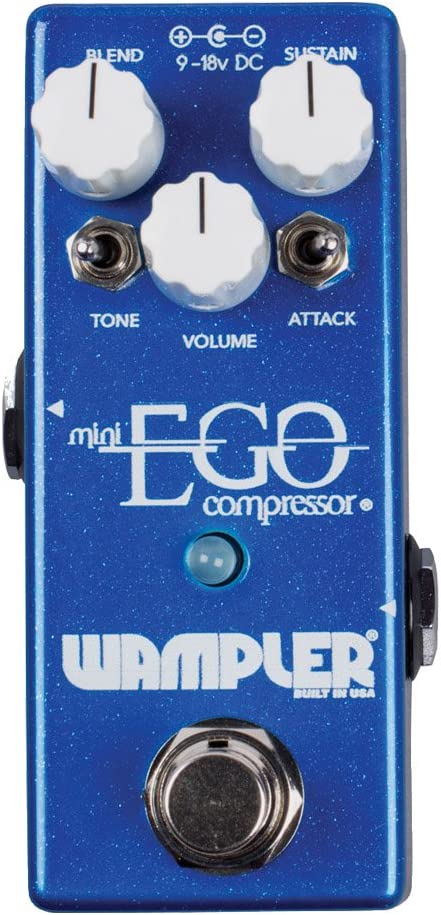
Meet the Wampler Mini Ego Compressor, a guitar effects pedal that sets a new standard for what today’s guitarists demand.
Housed in a compact design, it’s a refined version of the original Ego, boasting innovative features like tone switches for dark and bright sound variations and attack switches for slow and fast speeds.
Uniquely, this nifty device allows you to blend your original signal with the compressed one, giving you the advantage of compression without front-end squash.
It’s versatile enough to deliver everything from the full-on country squash to the subtler studio-level parallel compression.
With a pure core tone and an array of precise controls, it’s as handy as an ‘always on’ compressor as an ‘effect.’ Shaped and sized at 7x4x7 inches, it’s functional and light, weighing just 0.2 kilograms.
The Wampler Mini Ego Compressor truly redefines the expectations for guitar pedals.
- My Review
Diving headfirst into the world of the Wampler Mini Ego Compressor, it’s impossible to ignore its high-quality construction.
This little beast is built to last, making me confident in its longevity.
Its size makes it a convenient addition to my pedalboard, not eating up too much valuable real estate.
Looking at the controls, they’re simple yet effective, offering plenty of versatility.
Toggling the tone switch, it’s easy to alternate between bright and dark tones.
The sound quality, let me tell you, is excellent across the board.
It’s a pure core tone that remains impressively intact, even with heavy compression.
Something that caught my attention was the blend control.
This handy little feature allowed me to mix the dry signal with the compressed one, a balancing act that the Mini Ego performs effortlessly.
I could dial in the right amount of compression without sacrificing the integrity of my original tone.
It’s a significant step-up that brings you closer to achieving studio-quality sound, even at home.
However, it’s not all sunshine and rainbows.
The attack switch has just two settings, slow and fast, which can limit the options for those who enjoy having meticulous control over their attack time.
I must admit, though, for its size and price range, this is a compromise I’m willing to accept.
A considerable bonus is its quiet operation.
Even when cranked up, there’s a minimal noise floor, which you don’t always find in compressors in this price range.
Having experienced the Wampler Mini Ego Compressor, I can confidently say it is a robust, reliable, and exceptionally musical tool.
Here are the ratings I’ll give to the Wampler Mini Ego Compressor Guitar Effects Pedal:
It might have a small footprint, but its impact on your tone is substantial.
Despite minor drawbacks, it’s an incredible value for money piece that offers functionality and convenience in one compact package.
- Pros:
- Transparent and quiet compression
- Flexible controls for customization
- Compact size for pedalboard space
- Blend control for signal blending
- Great sustain and compression
- Cons:
- Possible noise issues with certain setups
- Some quality control concerns reported
- Switch pop issue when engaging the pedal
My final verdict is that the Wampler Mini Ego Compressor Guitar Effects Pedal is a highly versatile and feature-rich pedal with excellent tone and performance.
It offers transparent and quiet compression, flexible controls, and a compact size for easy integration into pedalboards.
While some reported quality control concerns and potential noise issues in specific setups had been reported, overall, the pedal provides great value for guitar players seeking a high-quality compressor.
MXR M291 Dyna Comp Mini Compressor Pedal
Space-saving Dyna Comp compression with adjustable attack and transparent tone.
This mini compressor pedal marries classic tone with modern convenience, featuring a rare “metal can” IC for quieter operation and increased dynamic range. It also has an Attack switch to toggle between slow and fast attack times.
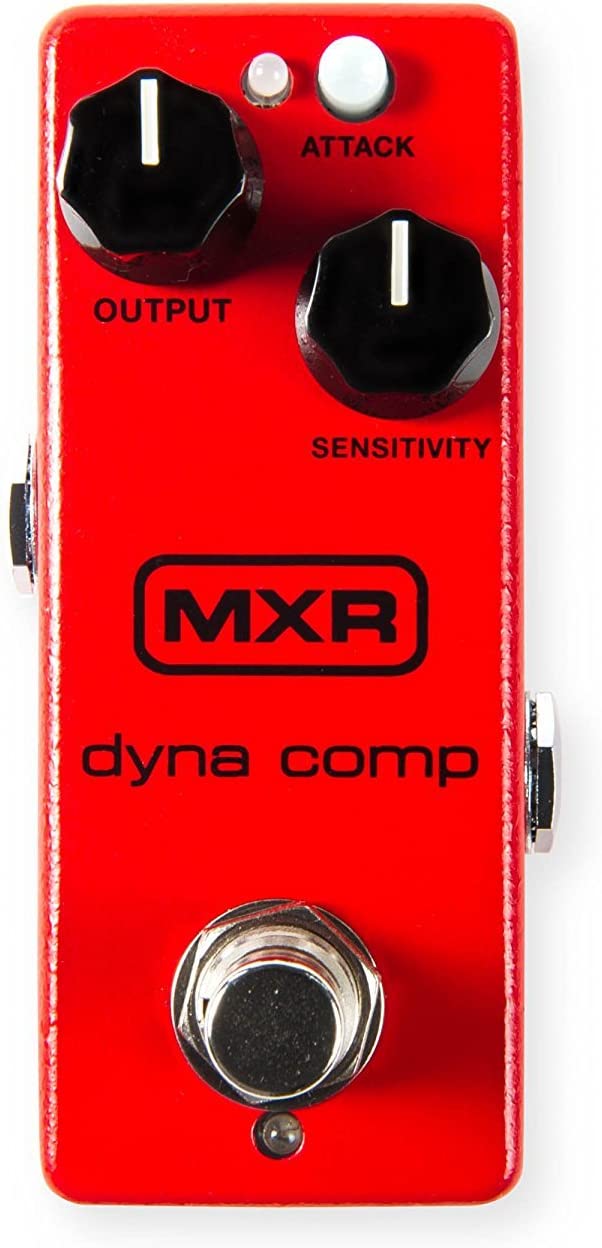
The MXR M291 Dyna Comp Mini Compressor Pedal is stepping into the limelight.
This little beast packs the renowned Dyna Comp compression into a compact form that’s just the right fit for any board.
It seamlessly integrates into your setup without compromising functionality, earning its keep.
Under the hood, you’ll find an authentic “metal can” CA3080 integrated circuit.
A unique find, this IC promises to keep operation noise at bay while enhancing transparency and broadening the dynamic range.
Functionality is not all it brings to the table, however.
Convenience and ease of use have not been overlooked.
Two standard controls, Sustain and Output, manage your sound, while a newly added attack switch allows you to switch effortlessly between slow and fast attack times.
Finally, let’s not forget the extras.
This bundle brings three 6-inch MXR Right Angle Patch Cables, ensuring you have everything you need right from the get-go.
- My Review
Jumping right into it, I must tell you about the MXR M291 Dyna Comp Mini Compressor Pedal.
This pedal was an absolute joy to incorporate into my setup.
Sporting a compact design, it slipped onto my board like a glove, saving precious space without compromising functionality.
Its features truly set it apart.
In particular, the “metal can” CA3080 IC chip left quite an impression on me.
It works wonders in reducing the noise floor while maintaining transparency.
Moreover, it significantly widens the dynamic range of sound, providing an elevated experience.
Speaking of controls, I found the Sustain and Output to be comfortably standard and easy to manage.
I didn’t have to fumble around or wrestle with them.
They did what they were supposed to overall, enhancing the convenience factor of this mini compressor.
Something that genuinely surprised me was the addition of the Attack switch.
It toggles between slow and fast attack times, opening up tonal possibilities.
Whether I wanted a subtle, softer sound or a punchy, hard-hitting tone, the switch had my back.
And let’s not forget about the bundled MXR 6-inch Right Angle Patch Cables.
Being bundled with the pedal, they truly round out the package.
Not having to hunt for cables to connect the pedal was a treat I hadn’t realized I needed.
Here are the ratings I’ll give to the MXR M291 Dyna Comp Mini Compressor Pedal:
However, I do want to point out that even though it’s a wonderful piece of gear, mastering the use of a compressor pedal, in general, can take some time, especially for beginners.
So, while the Dyna Comp Mini Compressor offers a fantastic experience, you’ll want to dedicate time to understanding its intricacies.
- Pros:
- Small form factor fits well on pedalboard.
- Classic MXR Dyna Comp compression.
- Transparent sound with lower noise floor.
- Includes 3 MXR 6-inch Right Angle Patch Cables.
- Cons:
- Limited control options (only Sustain and output).
- May not suit those looking for extreme compression.
- Requires a 9V power supply (not included).
My final verdict is that the MXR M291 Dyna Comp Mini Compressor Pedal Bundle offers a compact solution with classic MXR Dyna Comp compression.
It provides transparent sound, lower noise floor, and 3 MXR 6-inch Right Angle Patch Cables.
While it may have limited control options and may not suit those seeking extreme compression, it delivers well in terms of versatility, tone, performance, brand reputation, and value.
It is a solid choice for guitarists looking for a compact compressor pedal.
JHS Pulp N’ Peel V4 Compressor Guitar Effects Pedal
Transparent compression with added EQ, Dirt and outputs.
The Pulp ‘N’ Peel V4 is a transparent compressor pedal with a parallel compression circuit and Dirt mini toggle for added grit. It has both ¼” and balanced XLR outputs for bass or guitar, providing users with plenty of tone-shaping power.
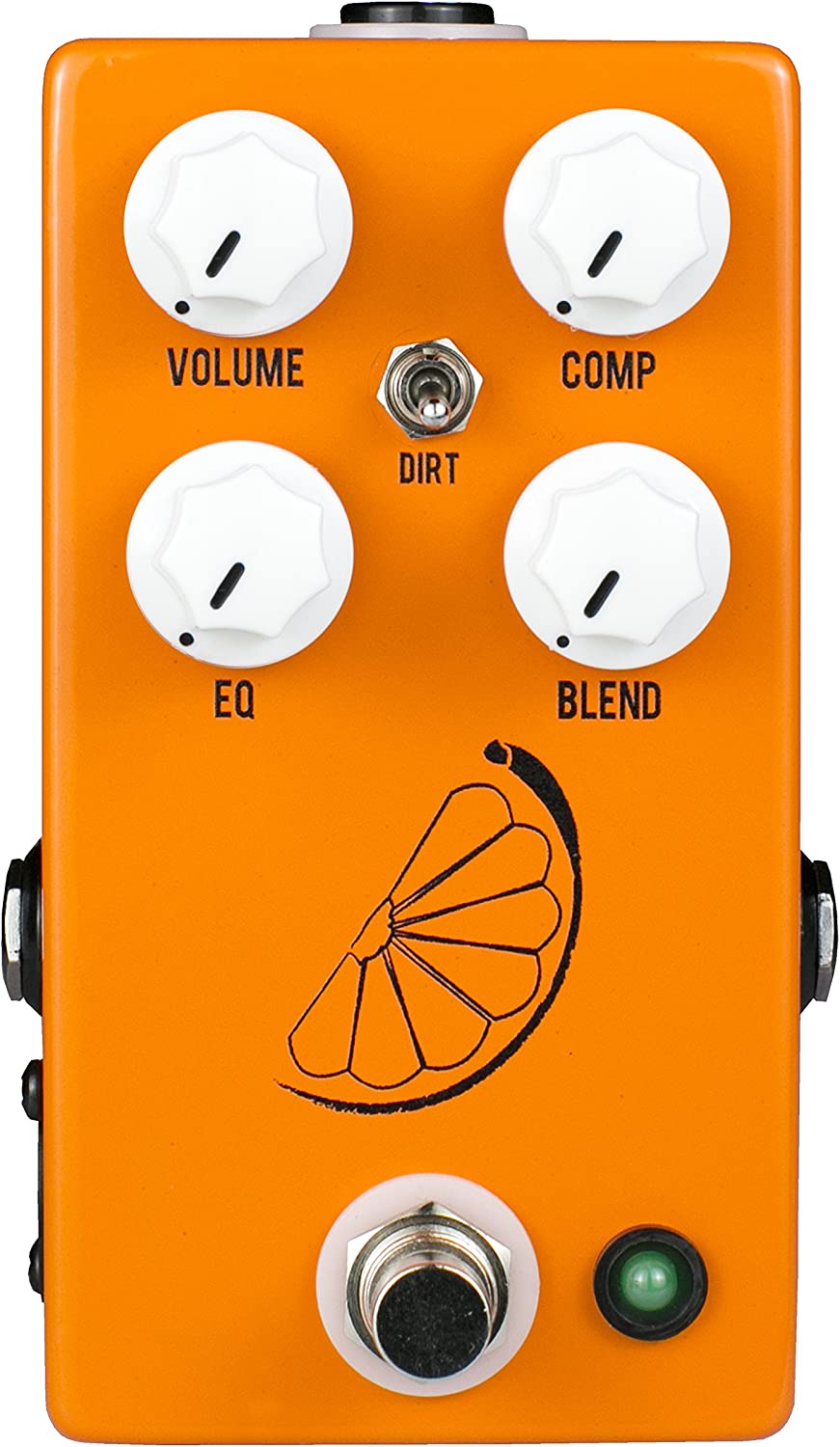
Picture this: you have a guitar in your hands and are ready to make some magic.
Imagine enhancing your sound with the JHS Pulp N’ Peel V4 Compressor Guitar Effects Pedal.
This isn’t your typical stompbox. Think of it as the secret ingredient for your guitar recipe, helping to balance your tone and provide unparalleled sustain.
Equipped with a top-notch EQ control, it enables you to customize your sound, while its parallel compression control gives you a handle on the blend of compressed and dry signals.
Wait, there’s more.
It sports a low-noise floor, so you’re always controlling your musical expression sans unwanted hums and buzzes.
Add in a Dirt toggle for a smidgen of grit, and you’ve got a versatile pedal as it is reliable.
For connectivity? Easy peasy.
It provides standard in/out jacks and a direct out, making this pedal a neat addition to any guitarist’s gear collection.
- My Review
Let’s get down to brass tacks about the JHS Pulp N’ Peel V4 Compressor Guitar Effects Pedal.
I enjoyed spending quality time with it, and it certainly made an impression.
First off, the design of this pedal is elegant yet functional.
Compact and sturdy, it fits right into a crowded pedalboard without any fuss.
Its intuitive control layout also made for a breeze when dialing in tones.
Good start, right?
What left me thoroughly impressed was the EQ control.
With this knob, fine-tuning my sound became effortless.
IT DELIVERED whether I aimed for a warm, vintage vibe or a brighter, modern tone.
That’s flexibility at its best. The parallel compression was something of a revelation too.
Offering a balance between the compressed and dry signals gave me control over my sound in a way I didn’t expect.
It’s not every day you find such sophistication in a pedal.
Now, onto its low-noise floor.
I don’t know about you, but unwanted hums and buzzes can be a deal-breaker for me.
With this pedal, noise interference was practically nonexistent.
Playing was a more immersive experience because of this.
Yet, there’s one thing I found somewhat off-putting.
Despite its versatility, the Dirt toggle switch felt a tad limiting.
It did add a dash of grit to the tone, but I was hoping for more range here.
The ‘grit’ felt like it lacked a bit of ‘oomph,’ you know?
Here are the ratings I’ll give to the JHS Pulp N’ Peel V4 Compressor Guitar Effects Pedal:
But don’t get me wrong. With its in/out jacks and a direct out feature, the pedal shines regarding connectivity.
It’s a neat little package that most guitarists would find handy, and despite a small gripe, it’s a pedal I wouldn’t mind having in my collection.
- Pros:
- Smooth-sounding parallel compression circuit
- Ability to blend compressed and uncompressed signal
- Added EQ knob for tone shaping
- Dirt toggle for added grit and tonal variety
- High-quality buffer switch for true-bypass or buffered operation
- Cons:
- Distortion issue with low settings on bass guitar
- Reported reliability concerns in some cases
- Minimal control over compression ratio
- Not ideal for dramatically altering tone
- Potential high-pitched hum in certain units
My final verdict is that the JHS Pulp N’ Peel V4 Compressor Guitar Effects Pedal is a versatile and feature-rich option with a strong brand reputation.
It excels in providing smooth compression, offering a blend control for added dynamics, and delivering excellent tone.
The pedal’s build quality reflects the brand’s commitment to craftsmanship.
However, it’s important to consider the reported limitations and issues, such as potential distortion on bass guitars and occasional reliability concerns.
The control over compression ratio is somewhat limited, and certain units have reported a high-pitched hum.
Considering its overall performance, brand reputation, and the value it offers, the JHS Pulp N’ Peel V4 Compressor Guitar Effects Pedal proves to be a solid choice for musicians seeking transparent compression and tone enhancement.
While it may have some drawbacks, its positive attributes and positive user feedback outweigh the limitations.
What exactly is a compressor pedal?
A compressor pedal is a highly essential piece of gear in music, particularly for guitarists and bassists.
At its core, a compressor pedal is a device that aids in controlling the dynamic range, which is the difference between the loudest and quietest parts of an audio signal.
To appreciate the importance of a compressor pedal, we must first understand the concept of dynamics in music.
Dynamics refers to the varying levels of volume in a song or performance.
In music, dynamics are crucial as they play a significant role in influencing the mood and intensity of the song.
The most emotional moments in music often come from carefully manipulating these dynamics.
However, extreme variations in dynamics can be problematic when performing or recording.
Imagine a guitarist playing a riff.
Some notes might be played more forcefully than others, leading to an inconsistent volume level.
This is where a compressor pedal steps in.
The primary function of a compressor pedal is to ‘compress’ the dynamic range of the audio signal that passes through it.
When a note is played too loudly, the compressor reduces its volume to a more manageable level.
On the other hand, if a note is played too softly, the compressor can boost its volume.
This leads to a more consistent and balanced sound.
Compressors work by automatically adjusting the volume of an instrument.

The main controls on a compressor pedal include threshold, ratio, attack, release, and make-up gain:
- Threshold: This is the level at which the compressor starts to work.
The compressor will reduce its volume if the input signal exceeds this level.
- Ratio: This determines the amount of compression applied once the threshold is exceeded.
For instance, a ratio of 4:1 means that for every 4dB above the threshold, the output will only increase by 1dB.
- Attack: This is how quickly the compressor works after the signal exceeds the threshold.
A fast attack will immediately tame the note, while a slow attack will let some of the note through before clamping down.
- Release: This is how long the compressor stops working after the signal falls below the threshold.
A short release time means the compression effect will end quickly, whereas a long release time means it will gradually end.
- Make-up Gain or Level: After compressing a signal, the overall volume may decrease.
The make-up gain control allows you to boost the compressed signal back up to a usable level.
Understanding these controls is crucial to use a compressor pedal effectively.
They allow the musician to shape the dynamics of their performance, which can significantly influence the tone and feel of the music.
A common misconception is that compressor pedals are only used to correct performance flaws.
While it’s true that a compressor can help even out inconsistent playing, it also has creative applications.
A musician can uniquely shape their sound by manipulating the attack and release controls.
For instance, a slower attack can create a swelling effect, as the note’s initial transient (or attack) is let through before the compression clamps down on the remainder of the note.
What should you consider when choosing a compressor pedal?
When selecting a compressor pedal, there are several factors to consider, ranging from sound quality and control features to building quality and brand reputation.
These considerations ensure you select a compressor pedal tailored to your unique musical needs and preferences.
– Sound Quality

The sound quality is arguably the most important aspect to consider when choosing a compressor pedal.
A high-quality compressor will preserve your instrument’s tonal characteristics while enhancing your sound with its compression effect.
A key component of sound quality is the noise level.
Some compressors can add unwanted noise or hiss to your signal, particularly when the compression ratio is high.
High-quality compressor pedals will have a low noise floor, maintaining the purity of your signal even with heavy compression.
Additionally, different compressor pedals can color your tone in different ways.
Some offer a transparent compression that doesn’t alter your original tone, which is ideal for players who love their current sound and merely want to control their dynamics.
Others will add a certain character or warmth to your tone, which can be desirable for those looking to shape their sound further.
– Controls and features

The level of control you have over the compression process is another crucial factor.
As previously explained, a good compressor pedal should provide controls for threshold, ratio, attack, release, and make-up gain.
However, some compressor pedals simplify these controls for ease of use.
For example, some might combine the threshold and ratio controls into a single “sustain” knob.
If you’re a beginner or prefer simplicity, such compressors might be appealing.
On the other hand, if you want to fine-tune your compression, a pedal with more comprehensive controls would be more suitable.
Some compressors also offer additional features like a blend or mix control, which lets you blend the compressed signal with your dry, uncompressed signal.
This is particularly useful for maintaining some natural dynamics while still getting the benefits of compression.
– Analog vs. digital

The debate between analog and digital effects is a long-standing one.
Analog compressor pedals use analog circuits and offer a warm, vintage tone that many musicians love.
They are often simple to use, with fewer controls than their digital counterparts.
On the other hand, digital compressor pedals use digital signal processing to emulate various compressors.
They are generally more versatile, with more controls and the ability to mimic different compressor types.

They might offer presets, multiple compression types, and even include additional effects like EQ or noise gating.
The choice between analog and digital depends on your personal preference.
Analog might be better for those wanting a simpler, warm-sounding compressor, while digital might be best for those seeking versatility and precise control.
– Build quality and durability

A compressor pedal’s build quality and durability is important, particularly for gigging musicians who require their equipment to stand up to heavy use and potential mishaps.
A robust and durable pedal should withstand consistent usage and the occasional knock or drop that may occur during transport or while being set up on stage.
When assessing the build quality of a compressor pedal, it’s helpful to look at the materials used in its construction.
For example, metal casings typically provide better protection and durability when compared to plastic ones, which may crack or break more easily under pressure.

In addition to the casing, it’s important to evaluate the quality of the footswitch and knobs on a compressor pedal, as these components will likely be the most frequently used parts of the device.
High-quality switches and knobs can withstand regular usage and provide a more consistent and satisfying playing experience for the musician.
– Presets and Versatility

Some digital compressor pedals offer presets, which are pre-programmed settings that mimic specific compression styles or sounds.
These preset can be especially advantageous for novices still learning to operate a compressor pedal.
Furthermore, they provide a convenient method for swiftly changing between various sounds while performing.
The versatility of a compressor pedal is another crucial factor to consider.
This refers to the pedal’s ability to accommodate various styles, instruments, and tonal preferences.
For example, some pedals provide multiple attacks and release time options, allowing you to fine-tune the compression response to suit your playing style, whether quick and punchy or slow and smooth.
Another aspect that contributes to a compressor pedal’s versatility is the wide range of ratio settings, enabling you to control the intensity of the compression effect.
Higher ratios are suitable for aggressive styles like hard rock and heavy metal.
Lower ratios are great for a more subtle, natural-sounding compression often used in jazz or folk music.
Furthermore, a versatile compressor pedal may include features like parallel compression, which lets you blend the compressed and uncompressed signals, and sidechain filtering, which can help shape the tonal characteristics of the compression.
These options offer greater control over the final sound and provide even more creative possibilities for musicians who play multiple genres or instruments, such as guitarists who switch between electric and acoustic guitars or bassists who play fingerstyle and slap techniques.
Choosing a versatile compressor pedal ensures it can adapt to your musical needs, whether playing an intimate solo acoustic performance or a high-energy, multi-instrument live show.
– Brand reputation

Brand reputation can often provide a reliable indication of the quality and reliability of a compressor pedal.
Established brands like Boss, MXR, and TC Electronic are renowned for their high-quality, reliable pedals.
However, don’t discount lesser-known or boutique brands.

Many smaller companies produce excellent compressor pedals with unique features or sounds.
Researching and trying out different brands can help you discover a hidden gem.
– Price and budget

The cost of the compressor pedal is, of course, a significant factor.
Compressor pedals can range from affordable to quite expensive.
It’s important to balance your budget with your needs and expectations.
An inexpensive pedal might be appealing but could lack sound quality or durability.
Conversely, an expensive pedal might have fantastic features and sound, but it might be overkill for your needs.
Consider what features are essential to you and try to find a pedal that offers these within your budget.
Remember, the most expensive pedal isn’t necessarily the best for your needs.
– Reviews and recommendations

Finally, it’s wise to consider reviews and recommendations when choosing a compressor pedal.
Online reviews can provide insights into the pedal’s sound, build quality, and usability.
They can also alert you to any potential issues or flaws.
Personal recommendations from friends, teachers, or fellow musicians can also be valuable.
They can offer firsthand experience and advice, helping you make an informed choice.
How to properly use a compressor pedal?
Navigating the world of guitar effects can be intricate, especially when you’re exploring the nuanced realm of compression.
Let’s dive into the proper usage of a compressor pedal, so that you can get enhanced control over your dynamics, helping you achieve a balanced, professional sound.
– Familiarize yourself with the controls and features
Before properly using a compressor pedal, it’s essential to understand its features and controls.
Typically, a compressor pedal will have a few main controls: threshold, ratio, attack, release, and level (or gain).
The threshold control adjusts the level at which the compression begins, while the ratio control determines how much compression is applied once the signal exceeds the threshold.
The attack control determines how quickly the compressor responds to the input signal, and the release control adjusts how quickly the compressor stops compressing after the signal drops below the threshold.
The level or gain control adjusts the output volume of the pedal.
Some compressors might also have a knee control, which adjusts how abruptly or smoothly the compression kicks in, and a blend control that lets you mix the compressed and uncompressed signals.
Understanding what each control does is crucial for using a compressor pedal effectively.
– Adjust the parameters to suit your musical goals
Depending on your musical goals, you will want to adjust the parameters of your compressor pedal differently.
For example, if you’re a funk guitarist looking to get that characteristic tight, punchy sound, you might want to set a lower threshold and a higher ratio to compress your signal strongly.
If you’re a blues guitarist looking for a more natural and dynamic sound, you might set a higher threshold and a lower ratio to compress your signal more gently.
The attack and release settings can also be tailored to your playing style.
A fast attack will quickly squash peaks, which can be useful for tight rhythm playing, while a slow attack will let some peaks through for a more dynamic and expressive sound.
Likewise, a fast release will stop compressing quickly, which can help maintain a sense of dynamics, while a slow release will smooth out your sound more.
– Incorporate the compressor pedal into your signal chain
Next, you’ll want to incorporate the compressor pedal into your signal chain.
The placement of the compressor in the chain can greatly affect your tone.
Commonly, the compressor is placed first in the chain before any other effects.
This allows the compressor to work with the raw signal from your instrument, evening out the dynamics before other effects process the signal.
However, some players prefer to place the compressor after gain-based effects like overdrive and distortion.
This can prevent the compressor from squashing the dynamics of these effects.
Experiment with different placements to see what works best for your sound.
– Set the threshold level for compression
Setting the threshold level is crucial as it determines when the compression starts.
If you set a low threshold, the compressor will start working when your signal exceeds a very low level, resulting in much compression.
This can be useful for creating a very even and controlled sound but can also reduce your dynamics if used excessively.
On the other hand, a high threshold means that the compressor will only start working when your signal gets quite loud, resulting in less frequent compression.
– Adjust the attack and release settings to tailor the pedal’s response
The attack and release settings can greatly influence the feel and response of the compressor.
A fast attack setting will cause the compressor to respond almost instantly when the signal exceeds the threshold, quickly reducing the volume.
This can result in a tight, controlled sound and potentially remove some expressiveness from your playing.
A slower attack allows the initial transient (the very start of a note or chord) to pass through before the compressor clamps down, leading to a more natural feel.
Similarly, the release control adjusts how quickly the compressor stops compressing after the signal drops below the threshold.
A fast release can make the compression less noticeable, while a slow release will make the effect last longer, smoothing out the dynamics over a longer period.
– Fine-tune the output level for balance in your tone:
After setting the other controls, you must adjust the output level or gain to balance your tone.
If your compressed signal is quieter than your uncompressed signal, it can feel like the effect isn’t working properly when you turn the pedal on.
Use the level or gain control to match the volume of your compressed and uncompressed signals, or add extra volume if desired.
– Experiment with different settings and styles to achieve your desired sound:
Finally, experimenting is the best way to get the most out of your compressor pedal.
Different styles of music and different playing techniques can benefit from different compressor settings.
Don’t be afraid to try extreme settings or to use the controls in ways that aren’t typical.
The more you experiment, the better you’ll understand how the compressor pedal can enhance your sound, and the more you’ll be able to use it as a creative tool in your playing.
How to order pedals on a pedalboard?
There is no one-size-fits-all approach to ordering pedals on a pedalboard, as the optimal arrangement largely depends on the specific sound you’re aiming for.
Usually, though, you will see guitar players mostly agreeing with this order:
Tuner > Filters/Dynamics > Pitch-based Effects > Overdrive/Distortion > Modulation > Time-based Effects > Looper
Aside from that, some general guidelines can help you achieve a balanced and versatile setup.
Let’s talk in detail about the order we just mentioned, but feel free to experiment and adjust to your own preferences:
- Tuner: Place your tuner pedal first to ensure your signal is in tune before passing through the other pedals.
- Filters and dynamics: Wah-wah, envelope filters, compressors, EQs, and noise gates should come next. These pedals affect your sound’s dynamic and tonal aspects, so it’s best to place them early in the chain.
- Pitch-based effects: Octavers, harmonizers, and pitch shifters should come after filters and dynamics since these pedals alter the pitch of your signal and work best with a clean, unprocessed sound.
- Overdrive and distortion: Overdrive, distortion, and fuzz pedals typically come next. They shape your guitar’s core sound, and placing them before most other effects ensures that those effects receive a strong, consistent signal.
- Modulation effects: Chorus, flanger, phaser, and tremolo pedals should be placed after overdrive and distortion effects. We do this to allow these pedals to add depth and movement to your sound without becoming overly distorted or overbearing.
- Time-based effects: Delay and reverb pedals should be placed towards the end of your signal chain. This allows them to create a sense of space and depth around the other effects, simulating the sound of a room or hall.
- Looper: If you use a looper pedal, it should be placed last in the chain. This ensures that you’re looping the entire signal, including all the effects you’ve applied.
Remember, these are just general guidelines and what generally works and sounds good.
The most important thing is to experiment and find the arrangement that best suits your personal sound and style.
For example, here’s one pedalboard signal chain that I always use:
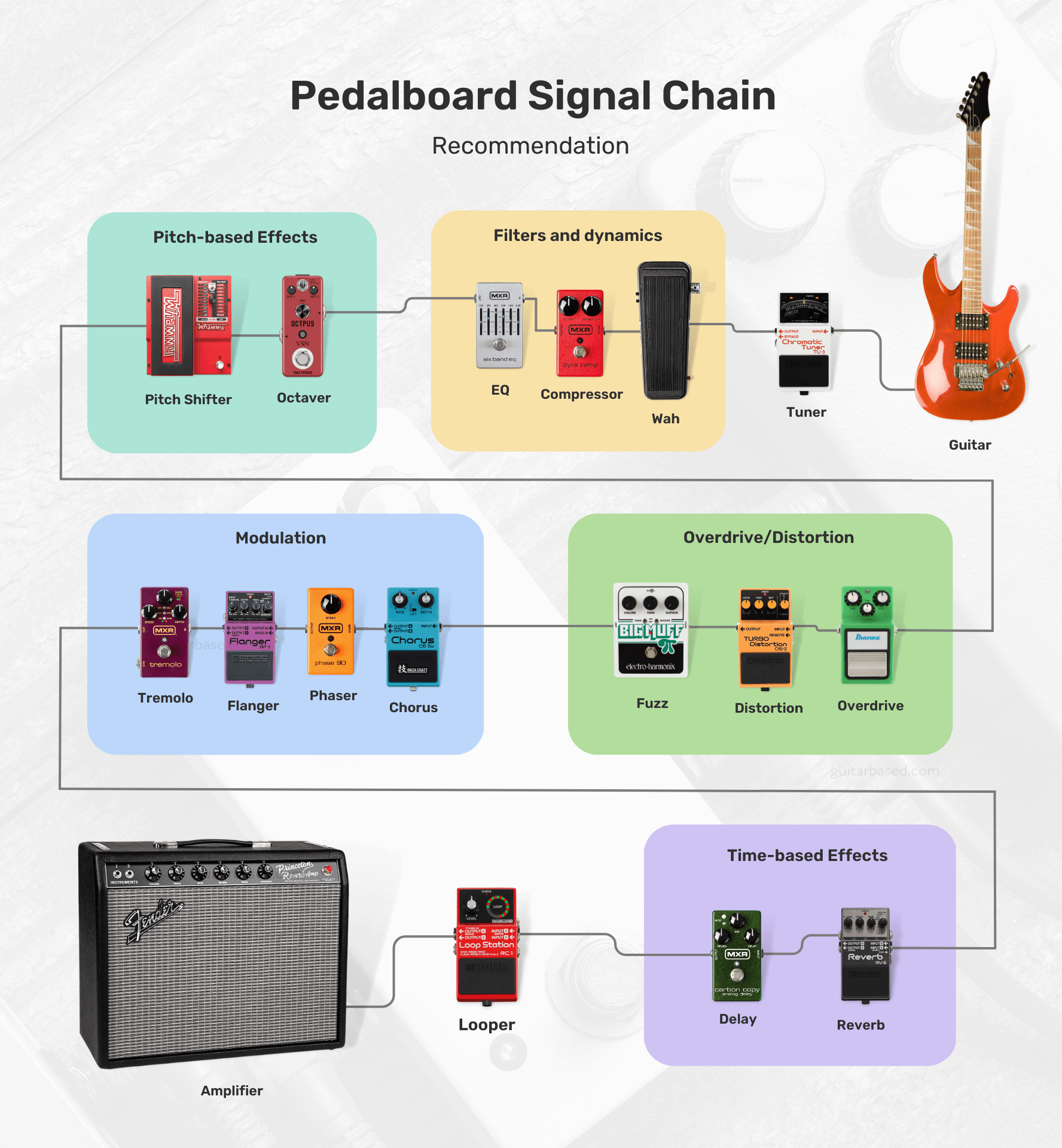
Feel free to swap the order of pedals, try different combinations, and test out unconventional setups until you find the one that works best for you.
For those interested, I’ll leave you with most of the possibilities that you’ll encounter and how to order them.
- Tuner
- Filters/Dynamics:
- Volume
- Wah
- Auto-Wah
- Compressor
- Noise Gate
- EQ (Equalizer)
- Pitch-based Effects:
- Octaver
- Harmonizer
- Pitch Shifter
- Overdrive/Distortion/Fuzz:
- Boost
- Overdrive
- Distortion
- Fuzz
- Modulation:
- Chorus
- Phaser
- Flanger
- Univibe
- Vibrato
- Tremolo
- Time-based Effects:
- Delay
- Echo
- Reverb
- Synth/Bitcrusher:
- Synth
- Bitcrusher
- Acoustic Simulator
- Multi-Effects
- Utility:
- Buffer
- A/B/Y Switcher
- MIDI Controllers
- Looper
Boutique vs. Mass-Produced pedals
Boutique pedals are generally built with higher-quality components and craftsmanship, resulting in better durability and longevity.
These pedals often feature unique and innovative designs, providing a wider range of tones and effects that may not be available in mass-produced options.
Here are a few examples of boutique pedals:

All the manufacturers also tend to have a more personal approach, with better customer service and the ability to customize pedals according to the user’s preferences.
However, boutique pedals are usually more expensive due to the smaller scale of production and the use of premium components.
Mass-produced pedals, on the other hand, are more affordable due to their larger scale of production and the use of cost-effective components.
These pedals are widely available and offer a range of popular effects, making them accessible to a larger audience.
Here are a few examples of mass-produced pedals:

The quality control for mass-produced pedals can vary depending on the brand and model, but many are reliable and offer good value for the money.
As for one of the downsides, you’ll find that mass-produced pedals may not have the same level of uniqueness or innovation as boutique options.
On the other hand, they may not provide the same level of customer service or customization options.
The choice between boutique and mass-produced pedals depends on your personal preferences, budget, and desired sound.
If you’re looking for unique tones, higher-quality components, and a more personal experience, boutique pedals may be the way to go.
But I would say, for those who are on a budget and need access to popular effects, mass-produced pedals might be a better fit.
It’s worth trying out both types to see which best suits your needs and playing style.
How much should you spend on a guitar pedal?
If I were in your position, I would first determine my budget and specific needs before deciding how much to spend on a guitar pedal.
For beginners, it might be more reasonable to start with affordable, mass-produced pedals to explore different effects without spending too much.
Guitar pedals can range in price from around $30 to over $400, depending on the brand, quality, and complexity of the effect.
As your skills and understanding of your preferred tone develop, you can gradually upgrade to higher-quality or boutique pedals.
One thing I would do is consider which effects are essential to your playing style and prioritize purchasing those first.
Allocating a larger portion of your budget to the most important pedals might be a wise choice, especially if you only need a few basic effects.
However, if you require a wide array of effects, you may want to consider more budget-friendly options or multi-effects units.
Keep in mind that higher-priced pedals often come with better build quality, unique features, and improved sound quality.
But I would also say that price is not always directly correlated with quality or suitability for your needs.
Sometimes, a more affordable pedal can deliver the exact sound you’re looking for, while a higher-priced option might not meet your expectations and are only expensive because of the brand reputation.
Can you use a guitar pedal with a bass guitar?
You can certainly use a guitar pedal with a bass guitar.
But it’s crucial to be aware that some guitar pedals may not be specifically designed to accommodate the frequency range of a bass guitar.
This could result in a less-than-ideal performance or an altered tone that might not be what you were expecting.
If you’re feeling adventurous and eager to experiment with your sound, don’t hesitate to connect your guitar pedals to your bass guitar.
This can be a fun way to explore different sonic possibilities, and you might even stumble upon some unique tones that complement your playing style perfectly.
Using a guitar pedal with a bass guitar may not always produce the desired results.
In some cases, the low-end frequencies might be lost, or the effect could sound too harsh or muddy.
To avoid these issues, you could consider looking into pedals that are specifically designed for bass guitars.
These pedals are engineered with the bass frequency range in mind, ensuring that your low-end remains intact and the effect sounds as intended.
In addition to bass-specific pedals, there are also multi-effects processors and pedals that cater to both guitar and bass players, offering a wide range of effects and tonal options.
These versatile units can be a great solution if you play both instruments and want a single device to cover your needs.
How to properly power your pedals?
When it comes to powering your pedals, you want to make sure you’re doing it right to avoid any noise issues or potential damage.
First, check each pedal’s power requirements, which you can usually find in the manual or on the pedal itself.
You’ll want to pay attention to the voltage (usually 9V, 12V, or 18V) and current (measured in milliamps or mA).
Now, you’ve got a few options for powering your pedals.
You can use individual power supplies or batteries for each pedal, but that can get messy and inconvenient.
I’d recommend going for a pedal power supply or an isolated power brick.

For example here are a few ones I recommend:
- Voodoo Lab Pedal Power 2 Plus Isolated Power Supply (My favorite)
- Rowin PW-1 Guitar Pedal Power Supply (Cheapest)
These babies can power multiple pedals at once, and the isolated outputs help prevent noise and ground loop issues.
Just make sure the power supply you choose can handle the voltage and current requirements of all your pedals.
When you’re connecting everything, use good quality power cables and keep them neat and tidy to avoid a tangled mess.
You might even want to use cable ties or cable organizers to keep everything in order.
In love with guitars, and gear; expert in all things music! Been writing about guitars for about 5 years and counting. Born in the ’90s. Alma Mater: University of Havana. Always curious, trying to understand the world. #TeamFender

